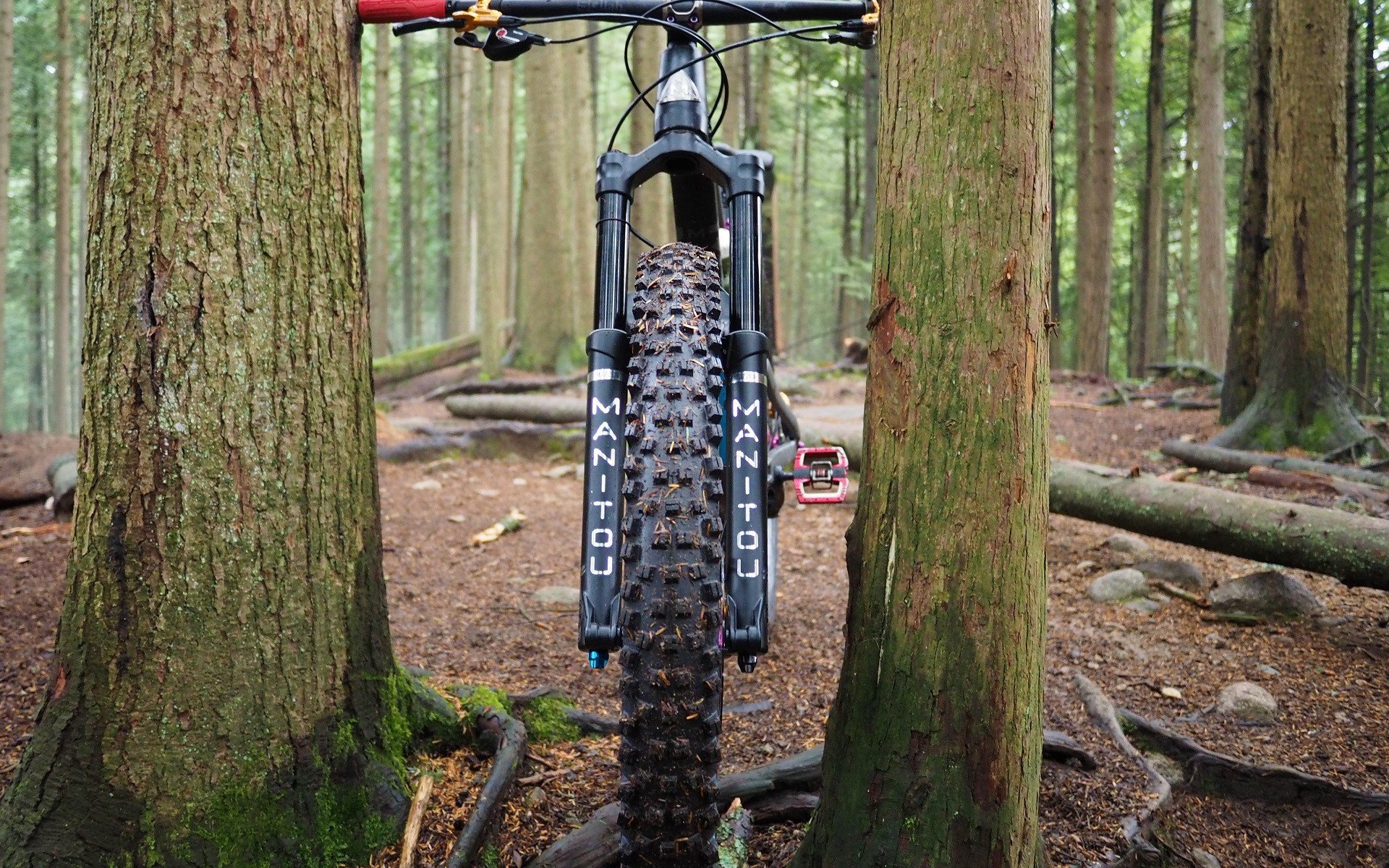
Teardown | First Impressions
Manitou Mezzer Pro Suspension Fork Ridden
Made To M37ZER
The new Mezzer Pro is absolutely the best-looking fork Manitou has ever made. Dorado what? I know, looks don't matter and you only buy based on performance, but think of all the people over the years who've poo-pooed Manitou forks because the Reverse Arch looks different. And then look at this thing. It's a BEAST!
Manitou has dropped the dainty looking Reverse Arch of yester-forks and fully embraced the aesthetic, while at the same time realigning to bring down axle-to-crown height without limiting tire clearance or going with a miserly steerer-tube insertion depth in the crown. Speaking of the crowns, the stanchion-crown pressfit overlap is massive and between the crown steerer, lowers, and HexLock axle my second impression of this up-to-180mm travel 29'er fork is "wow, that's surprisingly stiff."
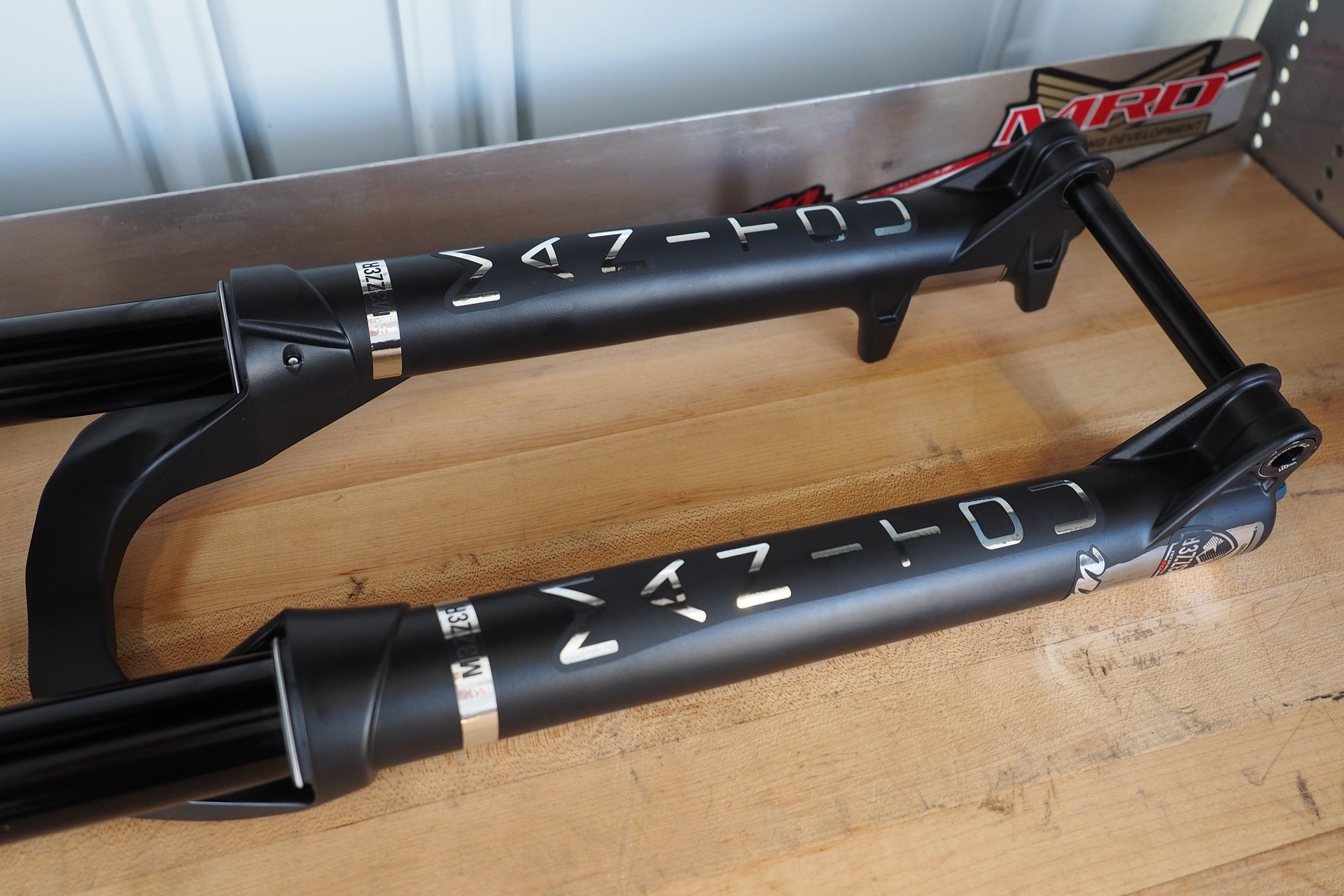
Two cable routing options make it easy to adopt the Mezzer without having to buy a fresh brake line by going up the front...
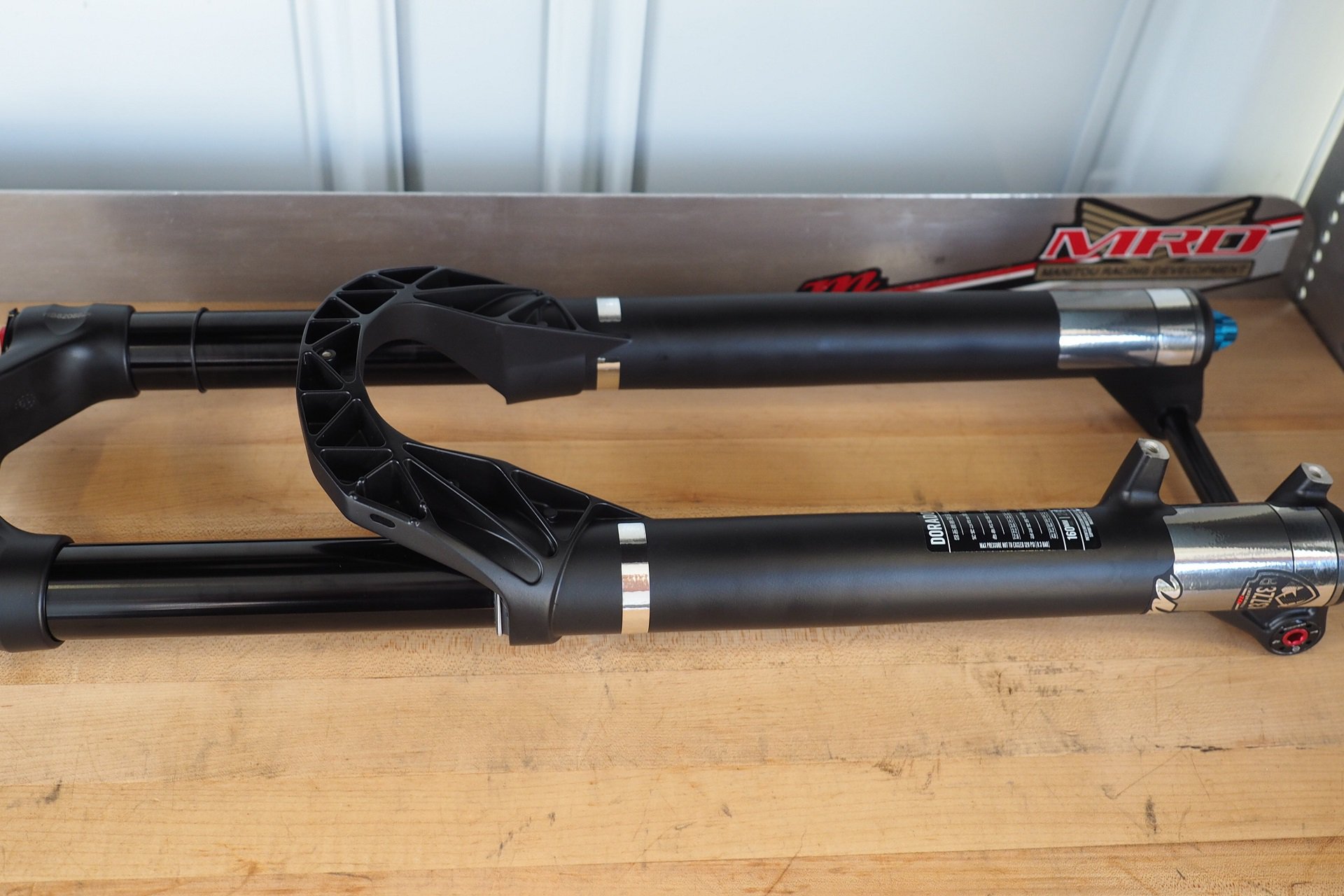
...or taking advantage of that so-clean Reverse Arch routing by zipping the brake line up the back. Choose your preferred position.
Pulling the 37mm-stanchioned fork out of the box, my reaction was, "wow, this thing is f***ing light." I weighed this 29'er Mezzer, travel reduced to 160mm with an uncut steerer, at 2070-grams, but my scale accuracy has become questionable so I'll verify that, with the steerer cut to 185mm, as part of the full review.
I'm not a gram-counter generally but the reason for my surprise is that the Mezzer is easily as stiff as the Suntour Durolux 29" which is at least 200-grams heavier with less travel and simpler guts. The one thing the Durolux has going for it is that I haven't made the CSU creak but hey, the Mezzer is here for a longterm test and I'm keeping an open mind based on my excellent past experiences with Manitou's chassis. Both forks sport a 44mm offset* so it's a good mano-a-mano comparison.
*Both forks are also available for 29'ers with 51mm offsets if that works better for your bike.
Air Guts
The new 37mm Mezzer chassis meets the much-loved Manitou Dorado IRT air system with up to 180mm of travel that's easily lowered with included parts and a machined cassette tool available from Manitou. My fork came setup at 160mm travel, the prescribed match for my Marin Alpine Trail, but it's so quick to swap travel pucks I'll absolutely be riding it at 170mm and maybe even 180mm on this bike. A 180mm fork pairs fine with 150mm of coil travel out back right?
IRT has two air valves and three chambers but it's actually bone simple to setup. First, fill the top valve (IRT) to 1/2 your body weight (lbs) in PSI. Then fill the bottom valve (+ve and -ve air pressure) to 1/3 your body weight (lbs) in PSI. From there I've made small adjustments to both the main pressure and the IRT to adjust the initial feel of the fork VS the amount of ramp-up VS the dynamic ride height. In truth adjusting this air system can be as simple or as complicated as you'd like it to be. There's also a handy pressure chart on the lowers that's surprisingly in tune with an aggressive set up for an even simpler starting point.
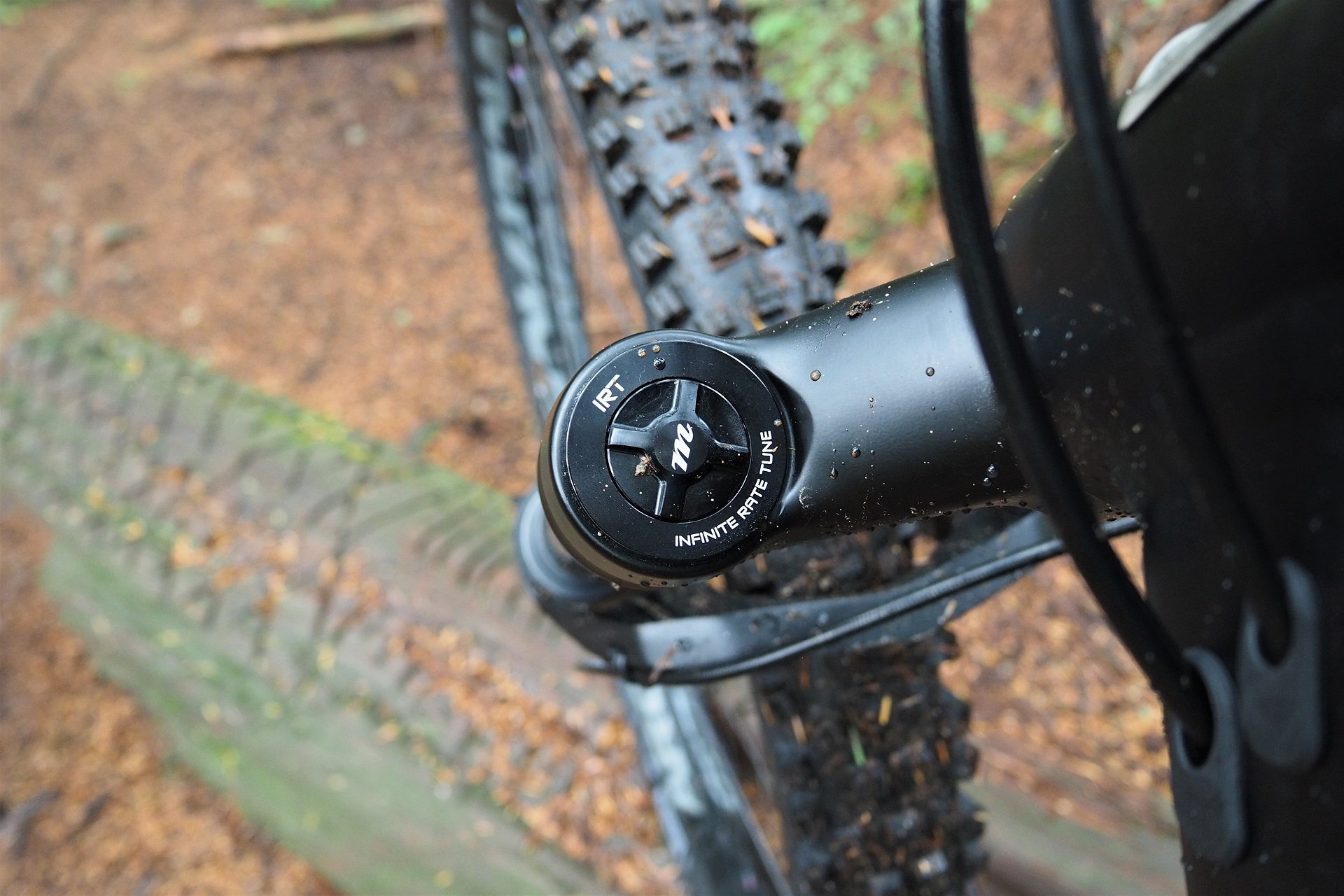
IRT valve. Fill this first to 1/2 bodyweight (lbs) in PSI. More = great ramp-up and higher dynamic ride height. Less = more linear setup.
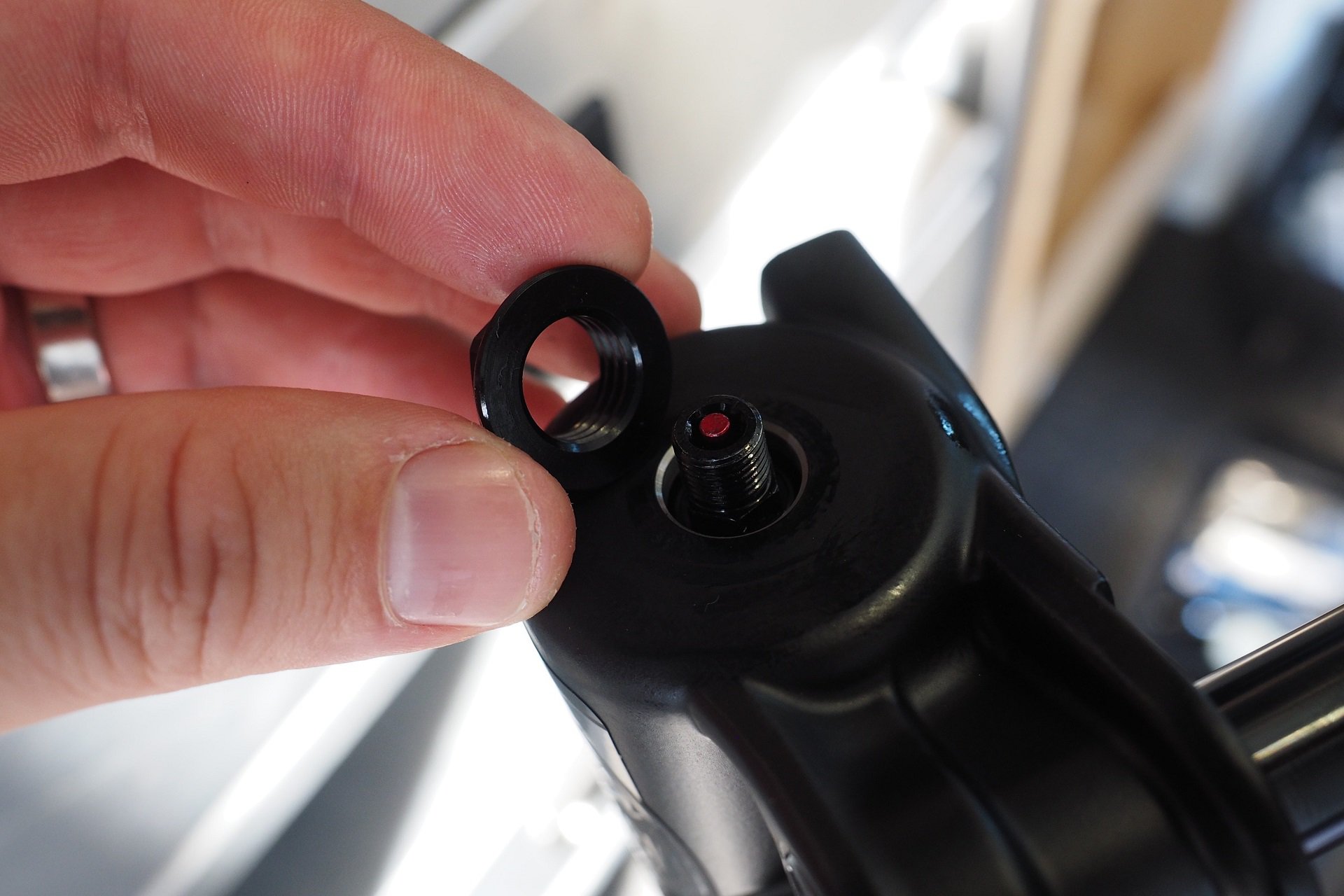
New foot nut configuration, same main air pressure valve to fill the +ve and -ve air chambers. Start with 1/3 body weight (lbs) in PSI.
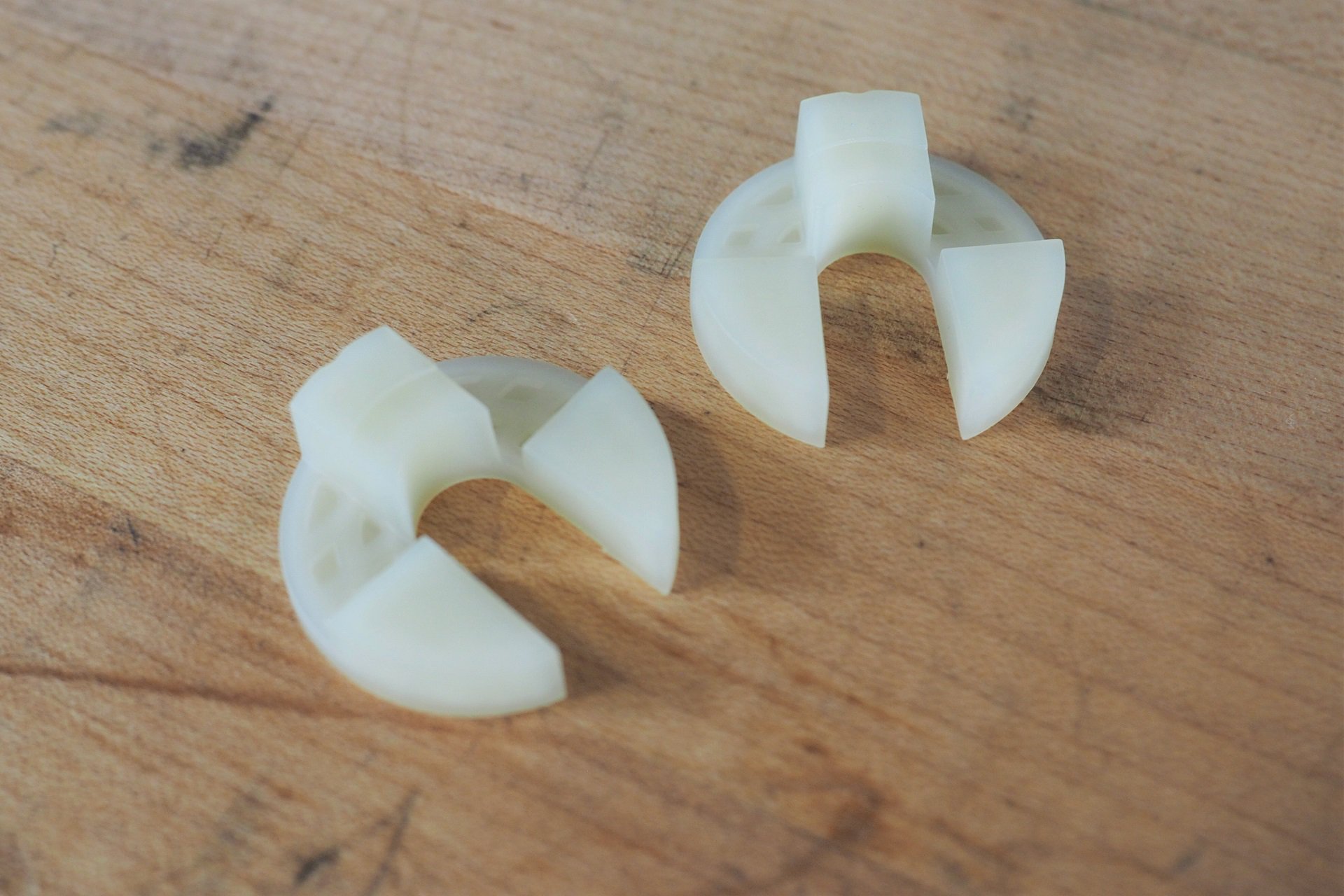
Stack those travel spacers. The Mezzer 29" and 27" forks can be run from 140mm to 180mm travel and the spacers are all included with the fork.
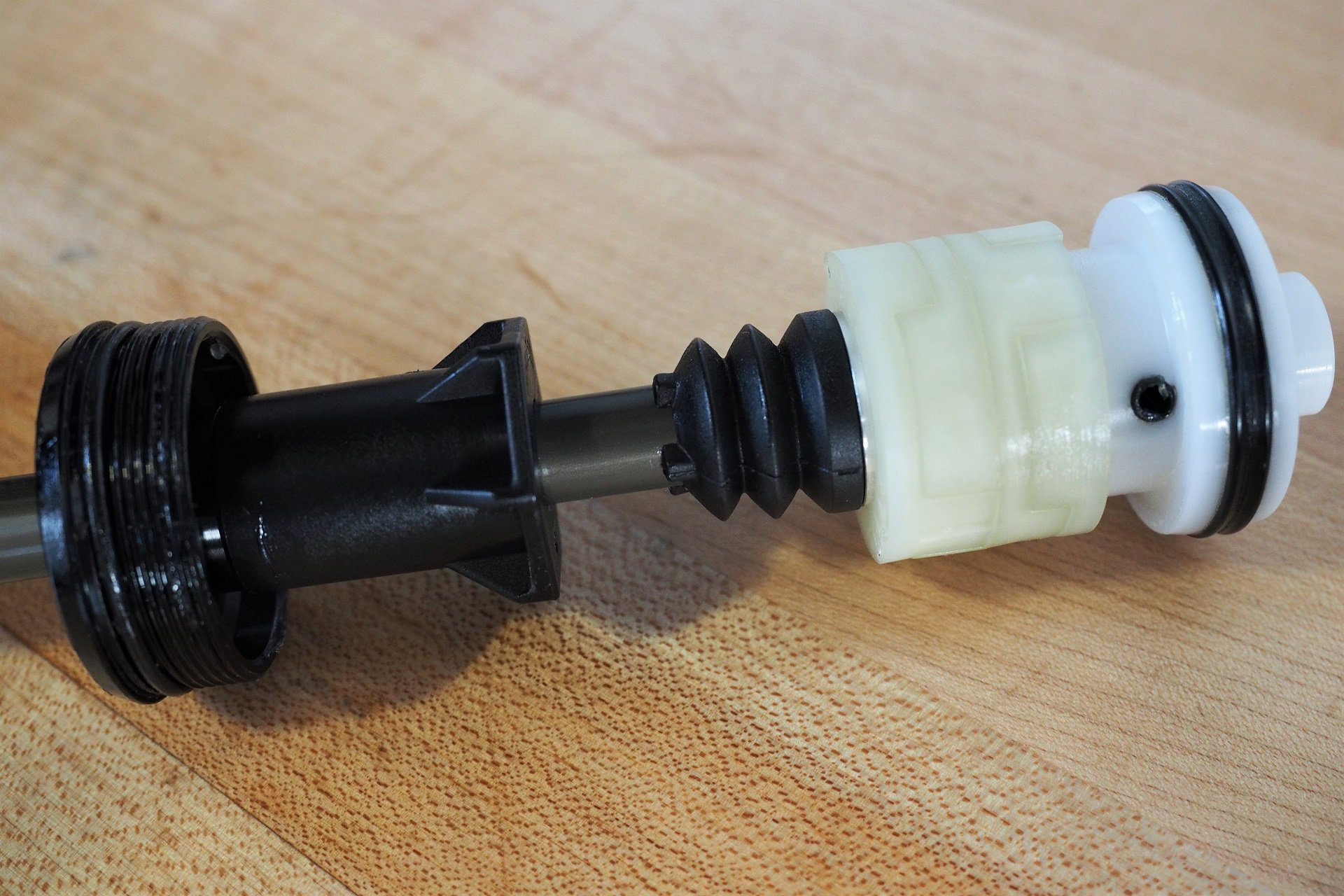
Travel spacers in action. The lowers do have to be dropped to change travel and I’ll have a step-by-step photo carousel in the full review.
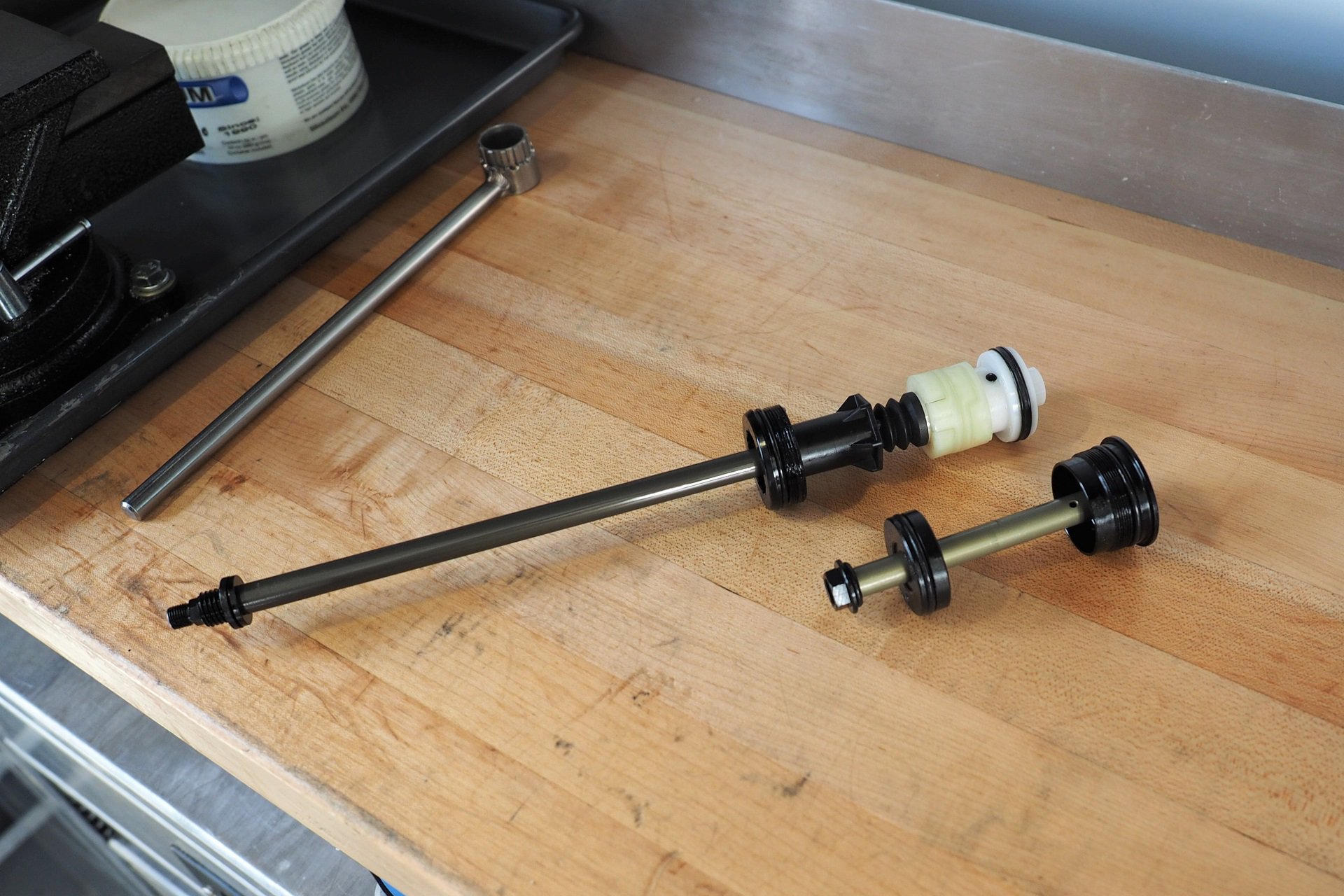
Dear companies that haven't adopted the HG-cassette tool standard for your fork top caps. Owning one tool is WAY BETTER than a full set of chamferless sockets. Sincerely, everyone.
The only tool needed to disassemble the Mezzer is an HG cassette tool with a couple of caveats. As I discovered with the e13 TRS+ dropper post teardown, not all of these tools are the same size and some do not fit the Mezzer top caps. And, to do a full teardown an HG tool that can fit over the air shaft is required. Manitou sells a service kit that includes this tool, the thin-wall 8mm (also needed to rebuild many pedals), and a 24mm socket for the damper for 65 USD.
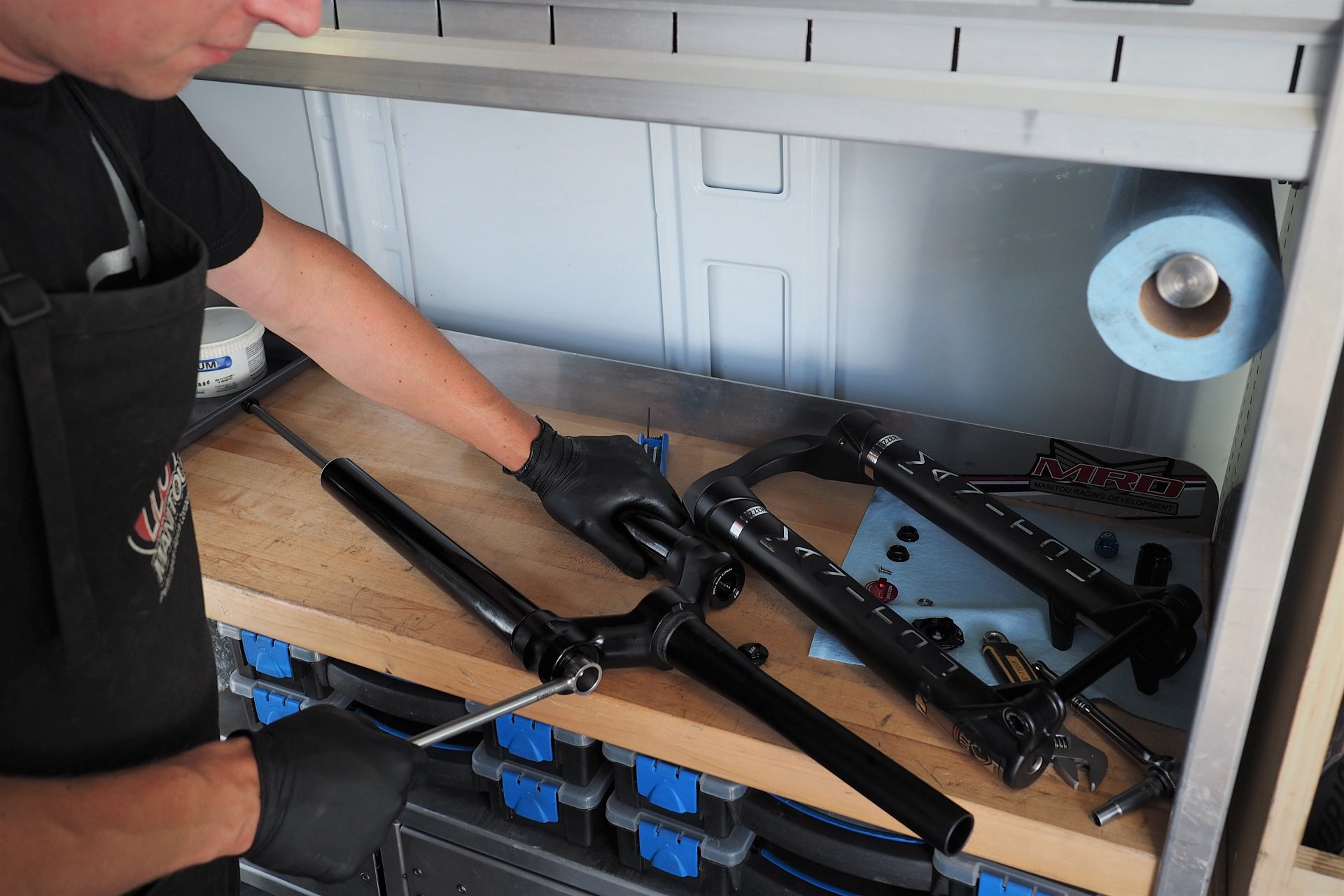
Zac at SmithTech pulling apart this Mezzer so we could take a look inside.
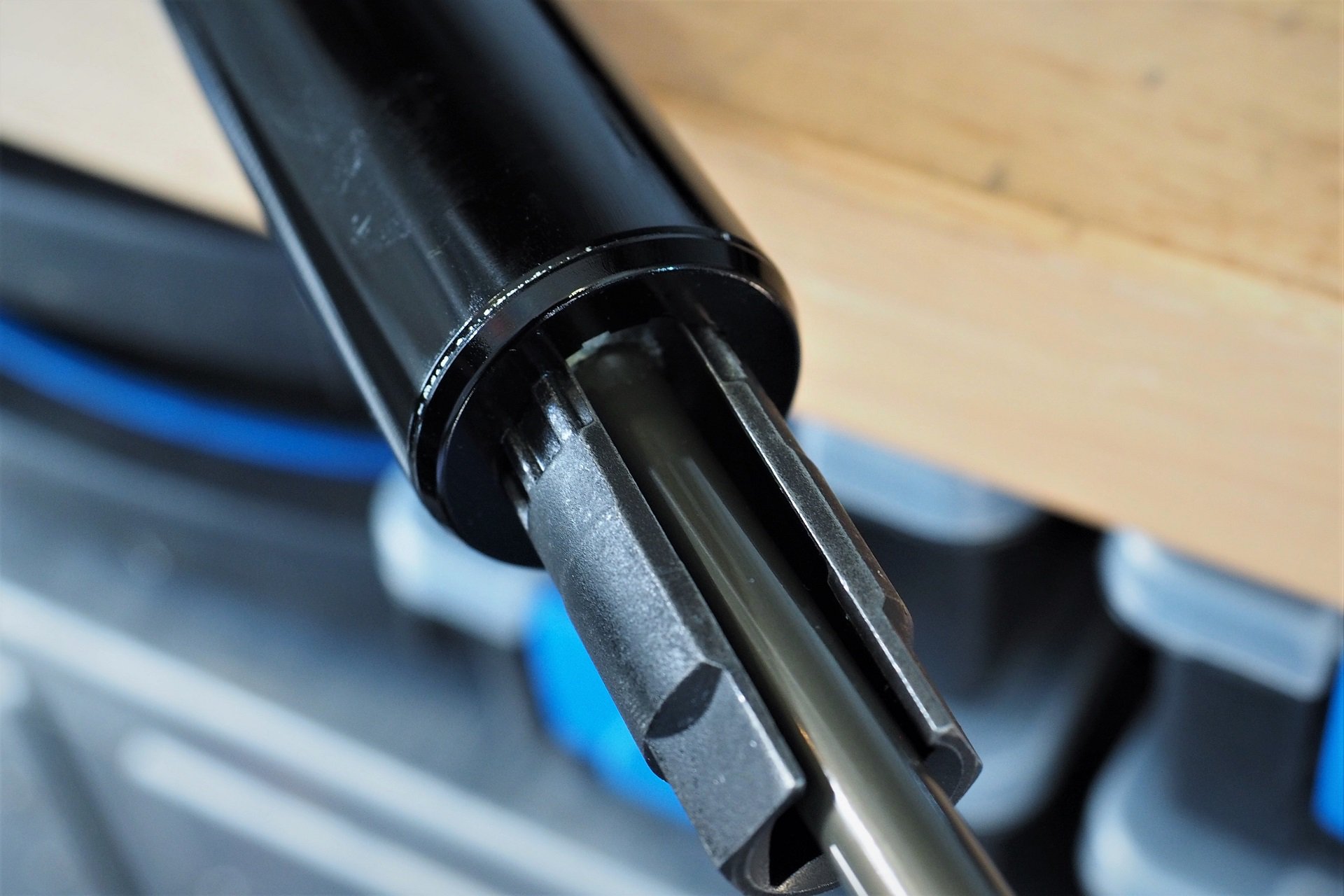
There's that special machined out end-cap socket. Manitou, please sell these on their own (or include one with each fork).
It's hard to commit to crowning a 'best air system.' I've had good experiences with a variety of different designs from Öhlins' self-contained cartridge to RockShox' latest Debonair, to the basic Suntour air system with a big-ass negative spring installed, but my expectations of the Mezzer's IRT system won't be met unless it's at least as good as the Mattoc Pro I've tested previously. It was my best fork testing experience to date.
Damper Guts
On paper, I'm excited about Manitou's new fully sealed MC² damper. My experience with the Mattoc Pro's TPC cartridge, with the foam compensator, was faultless and I also like being able to adjust the hydraulic bottom-out system,* but I'm absolutely a fan of sealed bladder dampers. For example, if I was buying a Fox fork I would choose a FIT damper over GRIP every day of the week because I ride a lot and I find they perform consistently better over the full period between service. The word is that any shop, or individual, who can bleed a FIT or Charger damper will have no issue with the sealed MC².
*Worry not. The excellent hydraulic bottom-out system is still in place but it's now factory set.
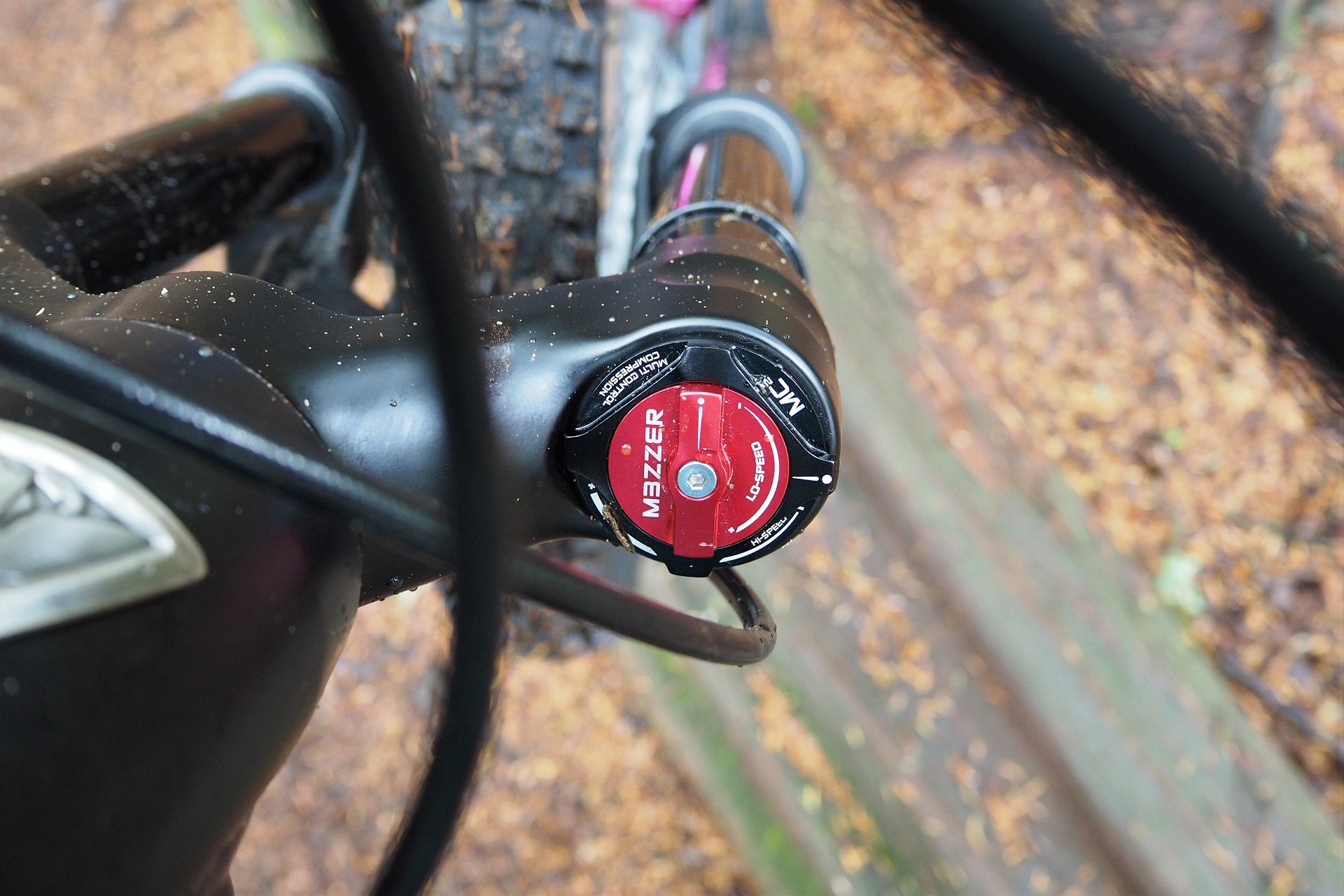
HSC and LSC up top and the low-speed rebound (LSR) adjustment is on the bottom. I get lots of support from the IRT air system and thus far I'm running the compression fairly open.
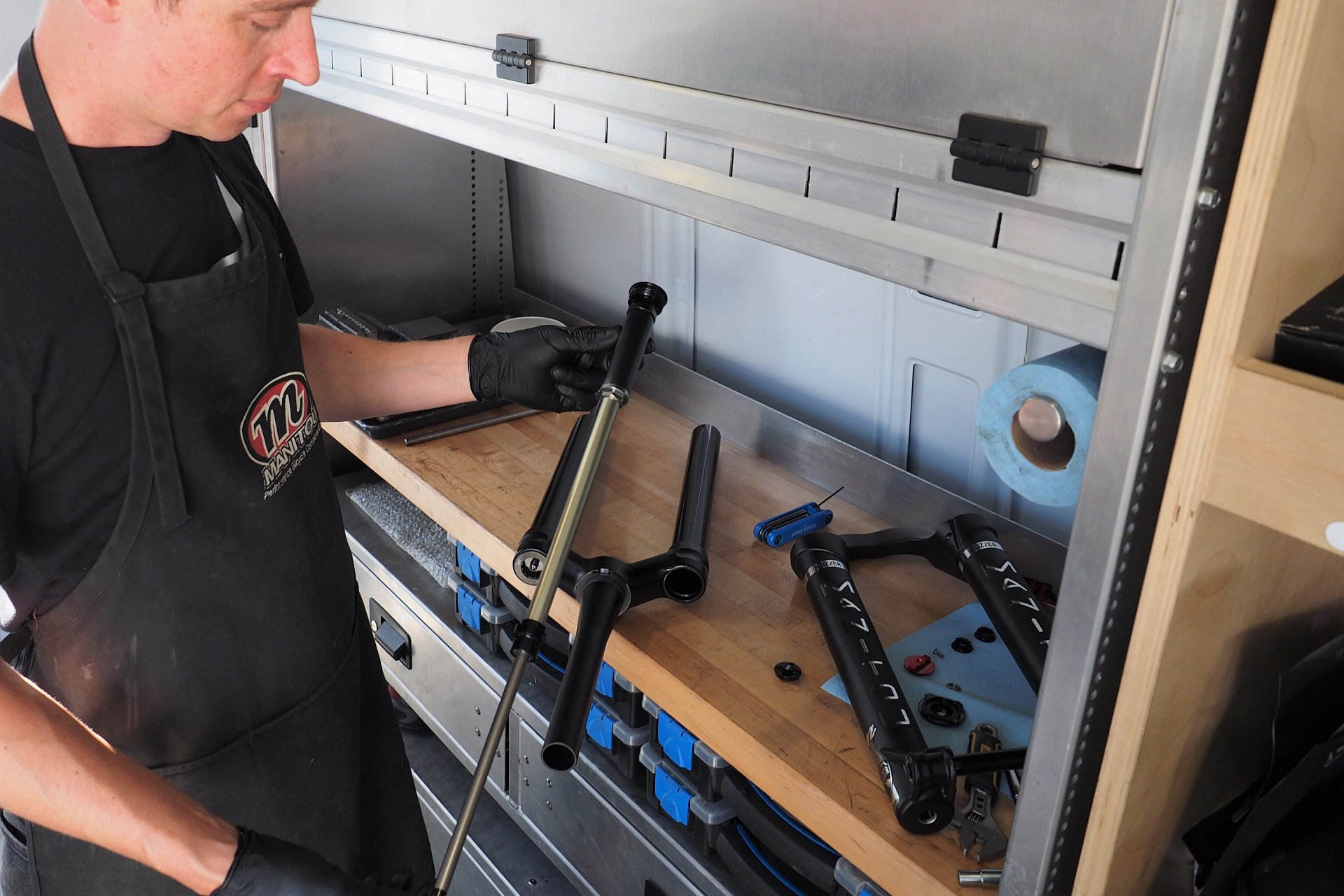
Zac pulls the sealed damper from the fork. It's tight quarters for the two of us working in his Sprinter Van.
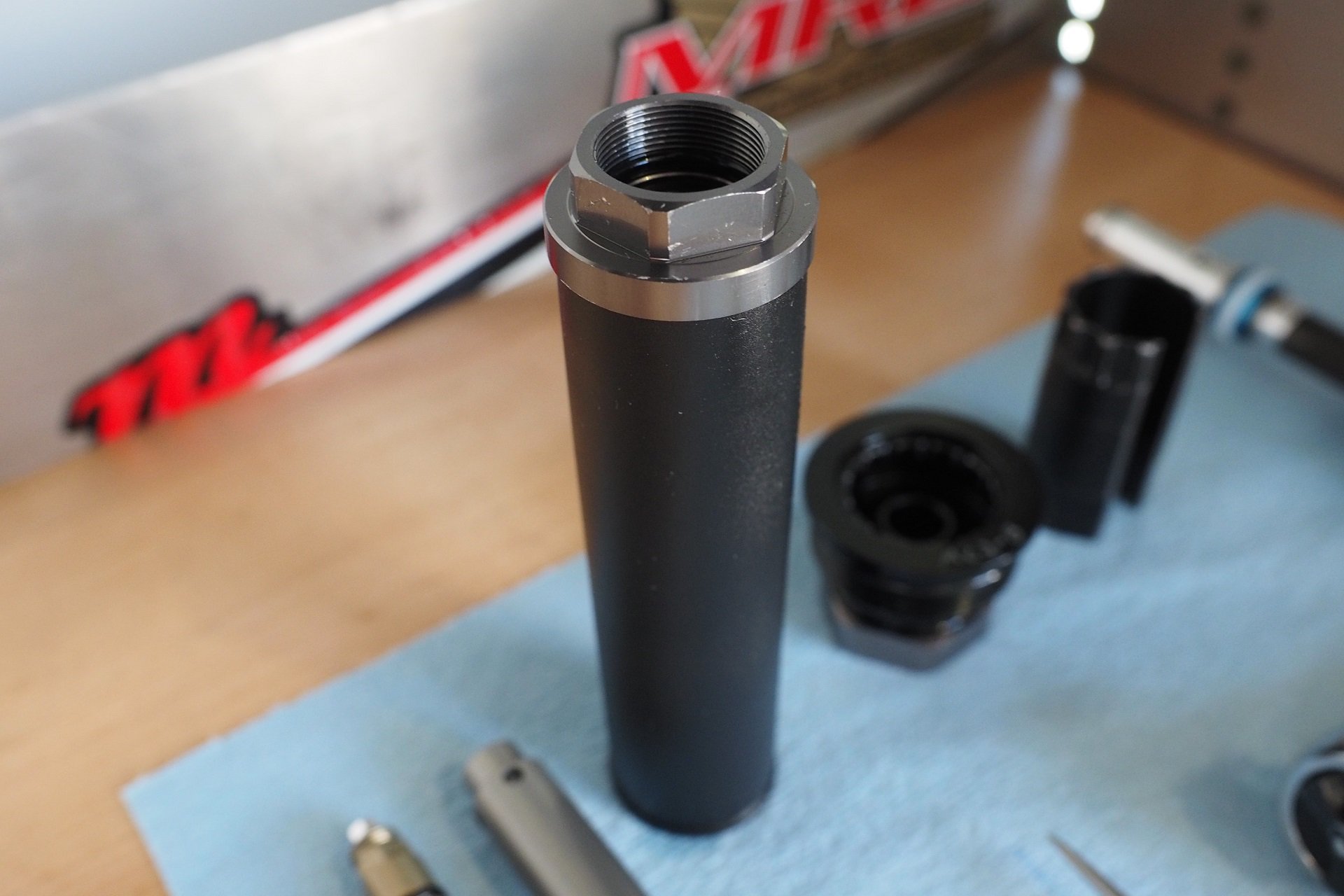
The bladder system has a blow-off so it won't rupture if it sucks in too much bath oil like some other dampers.
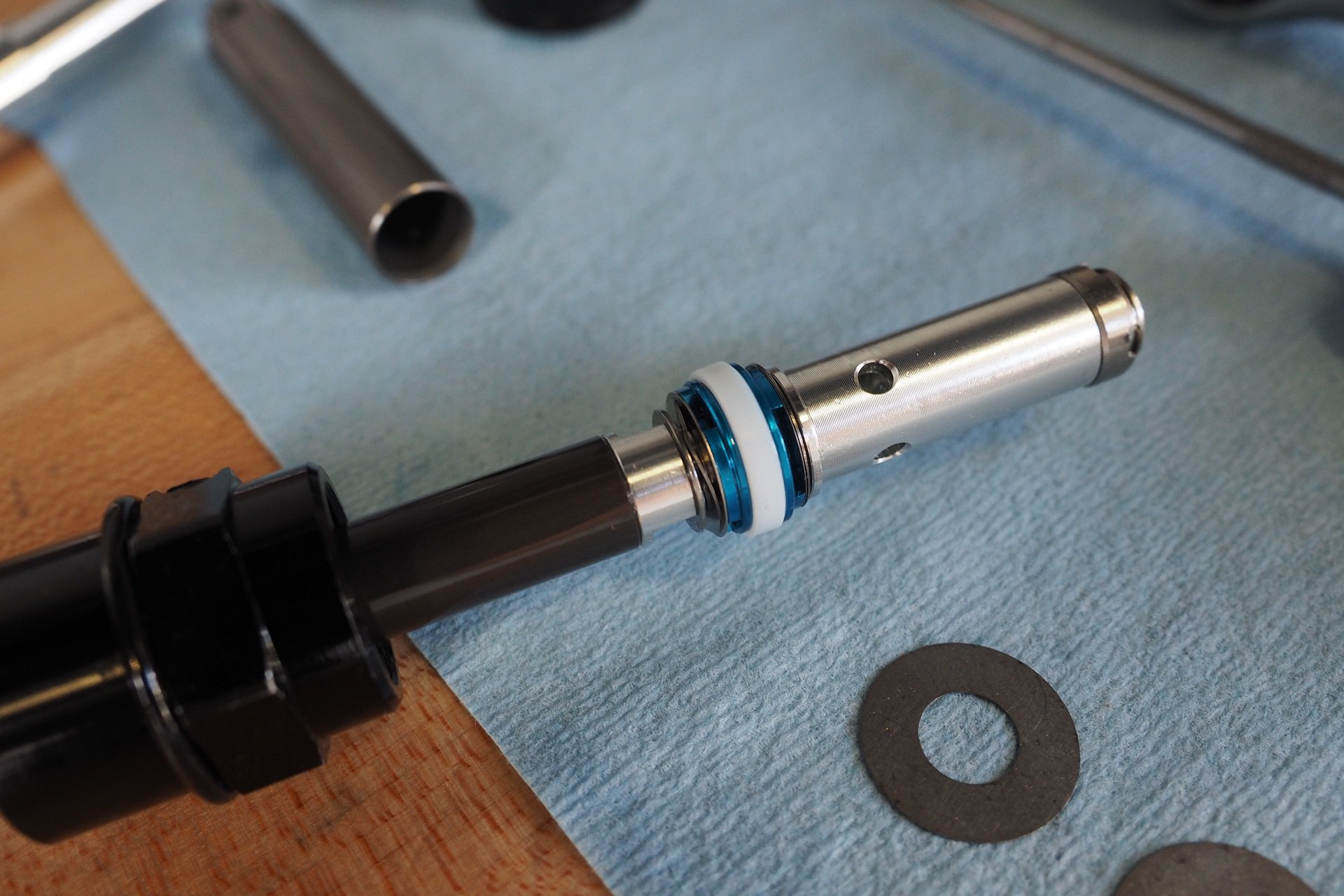
The hydraulic bottom out system is no longer adjustable but it is still present - just factory set. This was one of my favourite features of the Mattoc Pro.
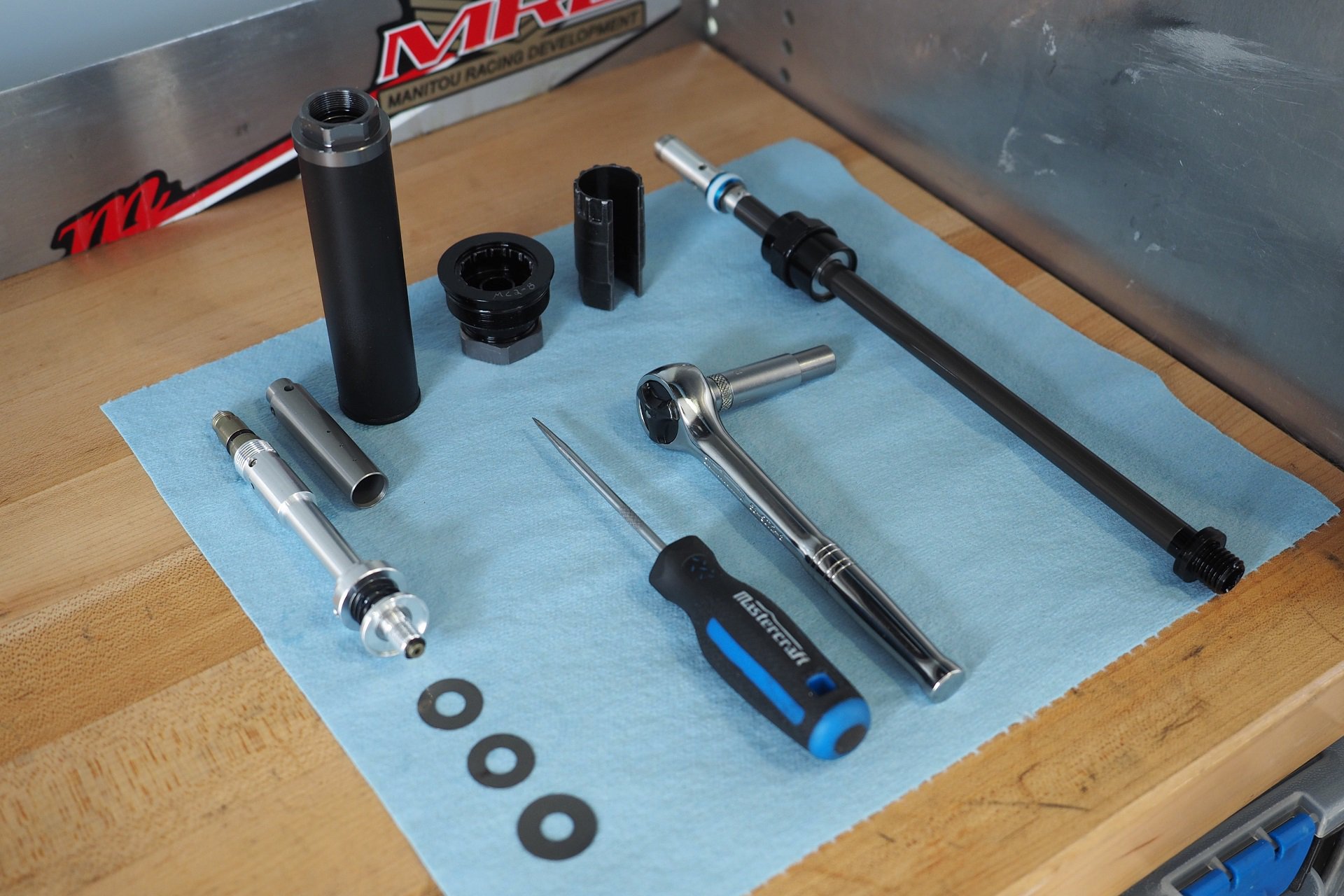
All the tools; all the parts. The Mezzer Pro is a premium fork at 1000 USD and the quality looks excellent as I'd expect.
Other Thoughts
I've owned a few Manitou Reverse Arch forks over the years, namely a couple of Shermans, and also ridden the Mattoc Pro extensively and I've never had feelings either way about their looks. This could be a Reverse Arch fork that combines the potential stiffness to weight advantages of the design with an aesthetic that doesn't say 'Canadian Tire bike with the fork on backward.'*
Combined with their new 20" kid's fork, I can really see the design catching on and it'll be exciting to see if other companies join DT Swiss and Manitou in flipping things around.
*Thanks Aaron for that analogy.
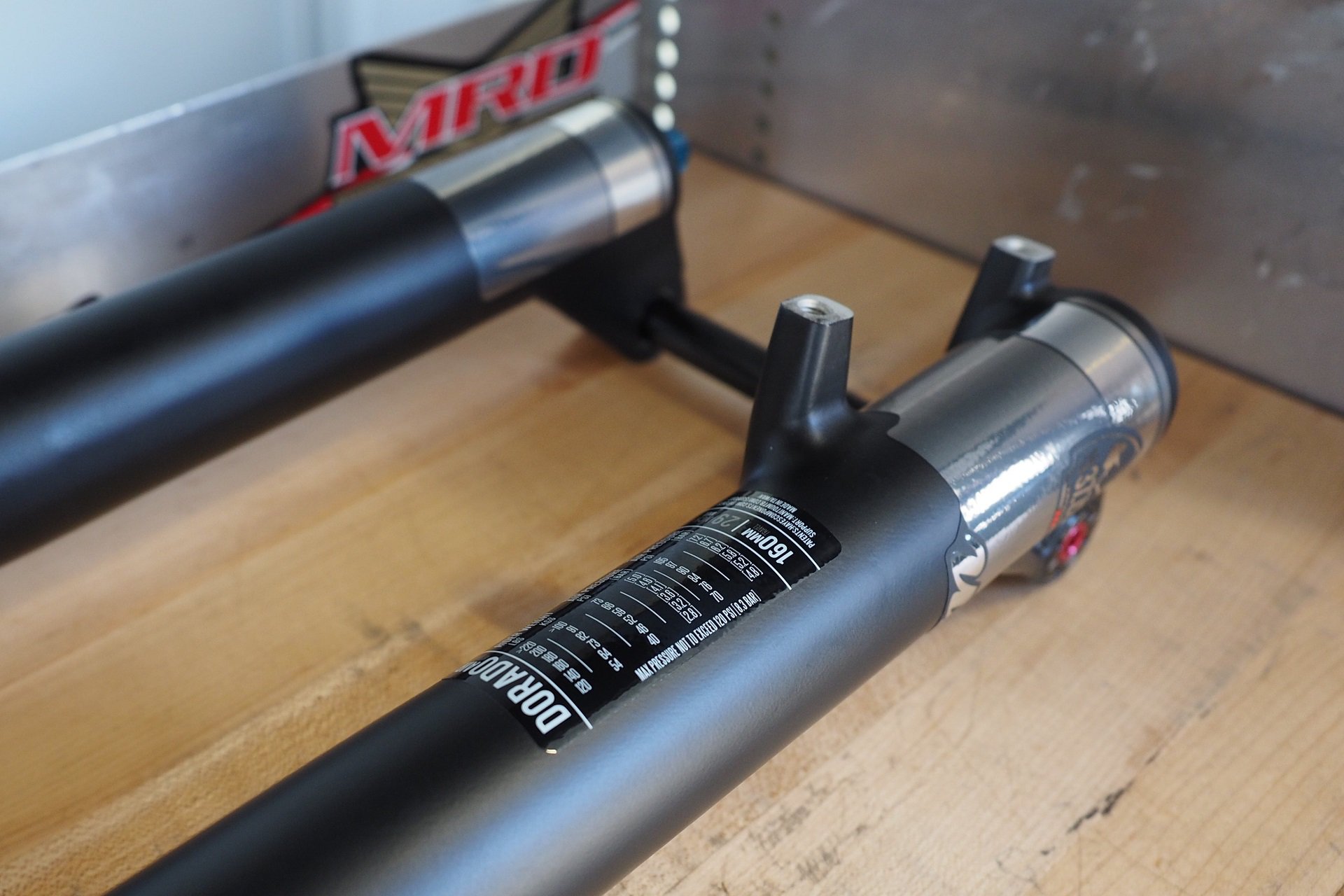
Is it time for companies to ditch PM-180mm mounts on long-travel 29'er forks and instead bump their lowers up to PM-203mm?
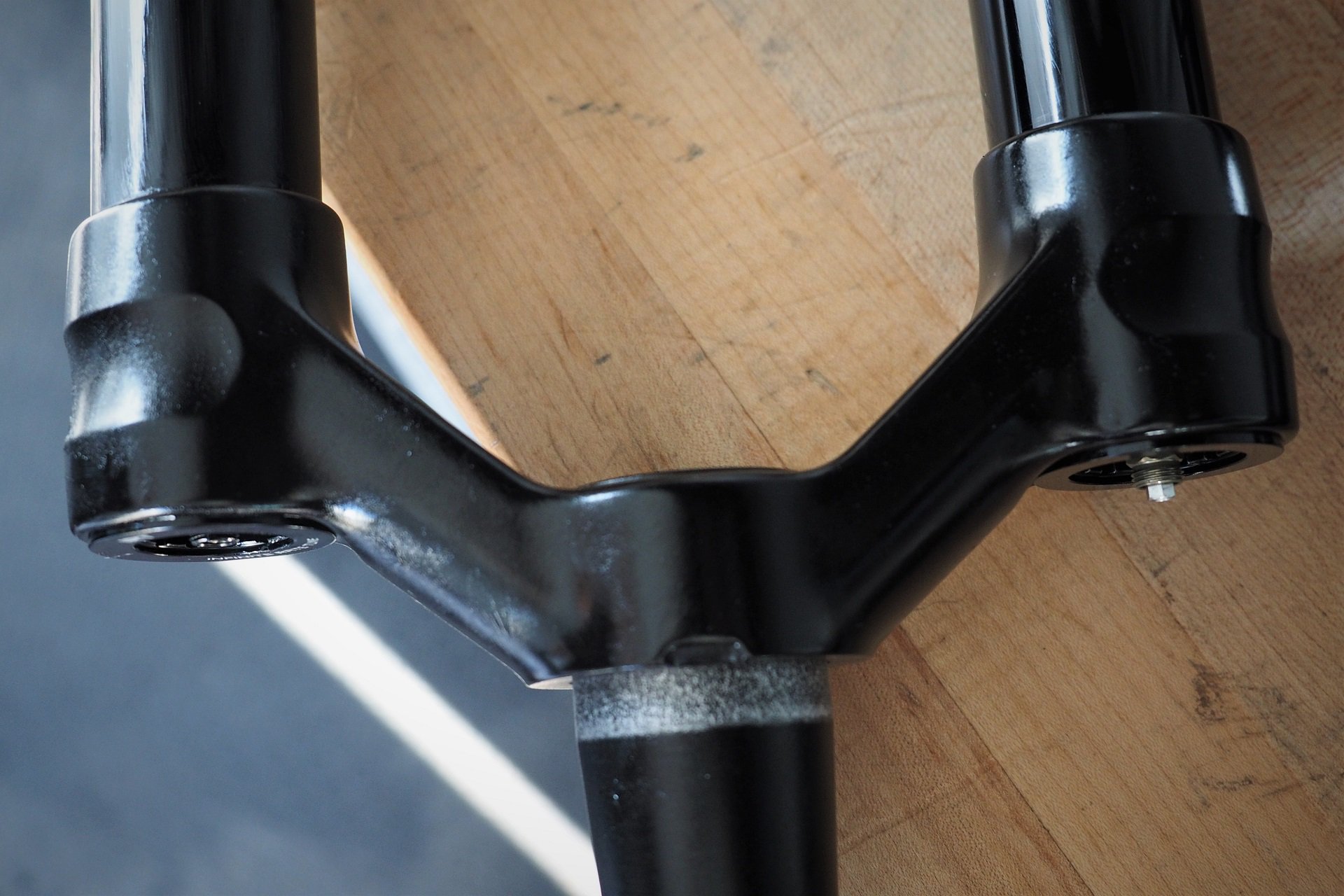
Goldilocks crowns? Generous stanchion and steerer overlap for stiffness and resilience and the weight is kept low thanks to a hollow crown and the 7050 material of the 37mm stanchions.
I'm currently running the fork with a set of Formula Cura4 four-piston brakes that are right up there in max power with the Magura MT-7. I'm running a 180mm rotor but it's a decently long travel 29'er and I go back and forth on whether a 203mm rotor would be better. Certainly, with most brake systems on the market, I'd be running the bigger rotor already. At the very least, if I was running a 203mm rotor I can't see myself being eager to downsize. This makes me wonder why companies producing beastly 29'er forks, like the Mezzer, don't just go straight to a 203mm Post Mount lower setup and ditch the adapter that I'd assume most riders will end up running.
Also, I really like Manitou's bolt-on HexLock axle system. This is my second experience with the 15mm Boost chassis and I think if everyone could just use this quick-and-easy one hex key setup we could kill discussion of other front hub axle sizes forever. Wouldn't that be nice? It's really quite lovely to use.
FIRST RIDES
The Mezzer Pro has plenty of clearance for my 29x2.8" Vigilante. Oodles of clearance. Massive amounts of clearance even. It does not however have clearance for both the mega-meat AND the flexible soft plastic fender that Manitou includes with the fork. It looks like it has clearance with everything installed but the fender has just enough wiggle-and-jiggle that I had some very-unwanted contact sounds at exactly the worst time for my brain to be thinking that my front tire was rubbing.
I love the clean bolt-on fender look but I'm not giving up my modern Gazzoloddi this winter, so my plan is to cut off the offending frontage of the fender and keep the part that will actually stop sh*t from flying up into my face. It hasn't happened yet, but I'll update in the comments of this piece and include my experience in the full review once I've had a chance to get out the snips.
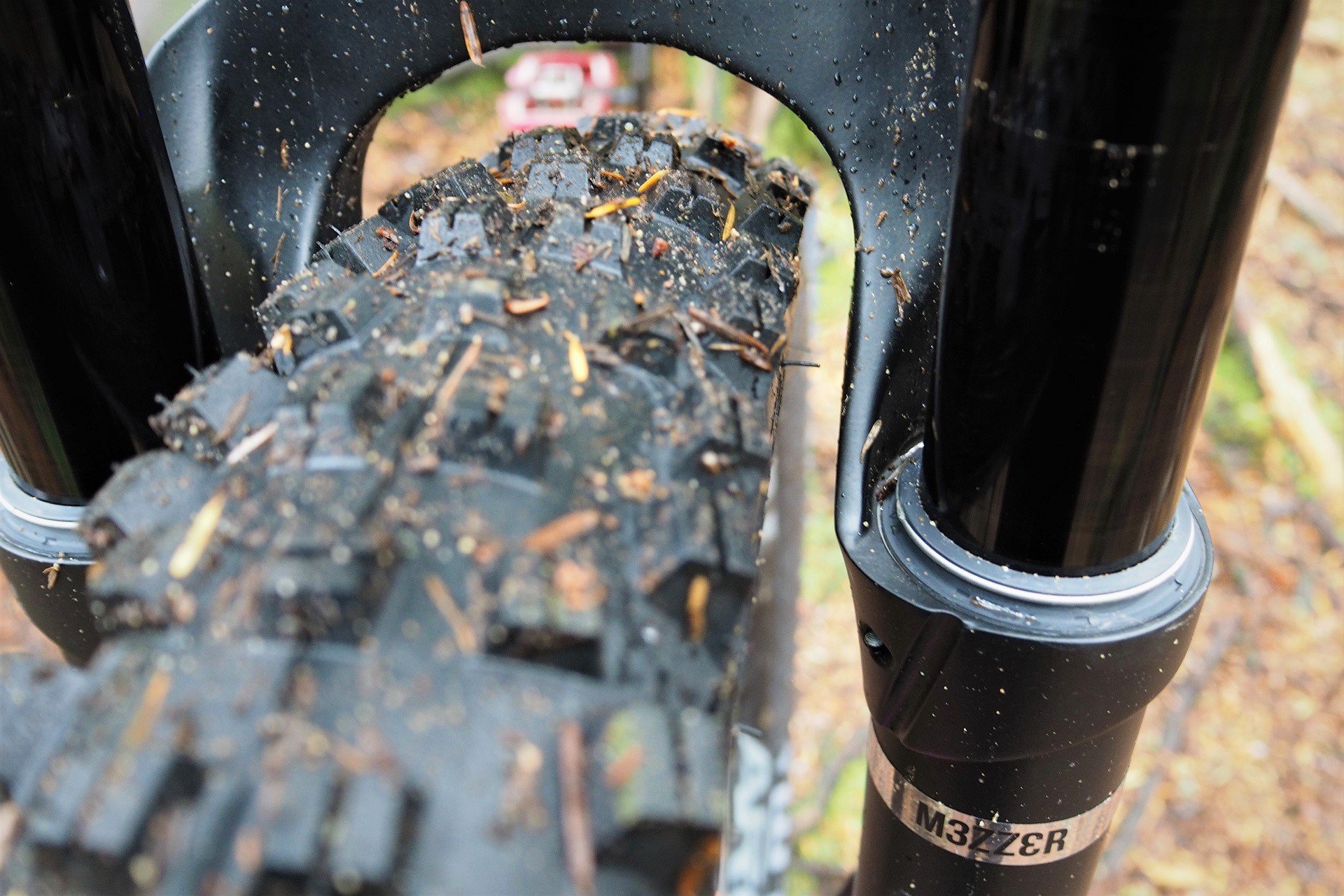
There is plenty of clearance all around with a 29x2.8 WTB Vigilante HG/TC tire on an i39 rim.
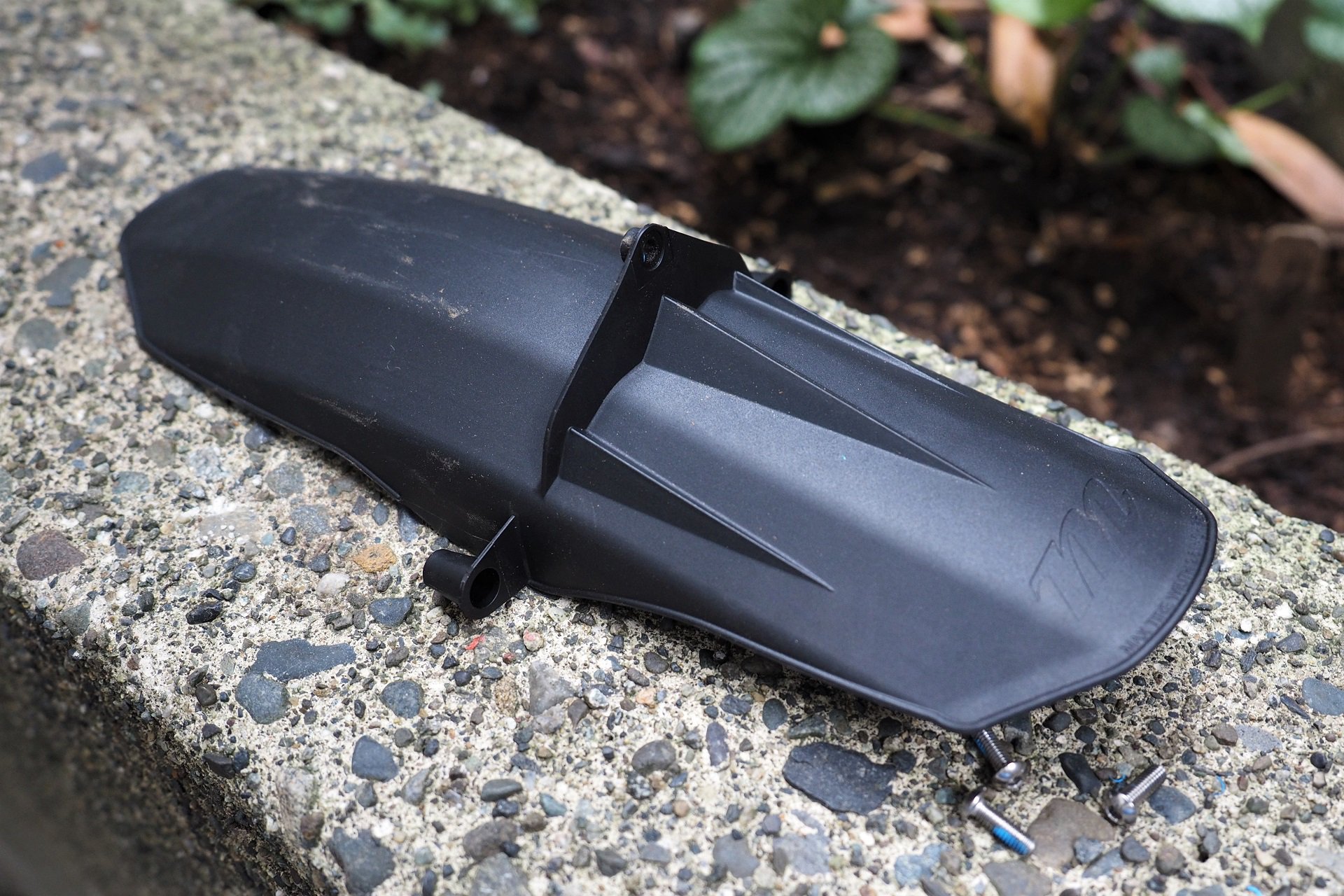
Clearance looks okay with the soft-plastic fender installed, however, there was contact with the big-big front rubber.
After faffing about with my multi-tool and strapping the fender to my hip-pack it was back to full-party. I purposely didn't bring a shock pump on my first ride as I'd dialed in the sag at home, had a good idea of how I like the IRT to feel, and I really just wanted to get out and ride my damn bike.
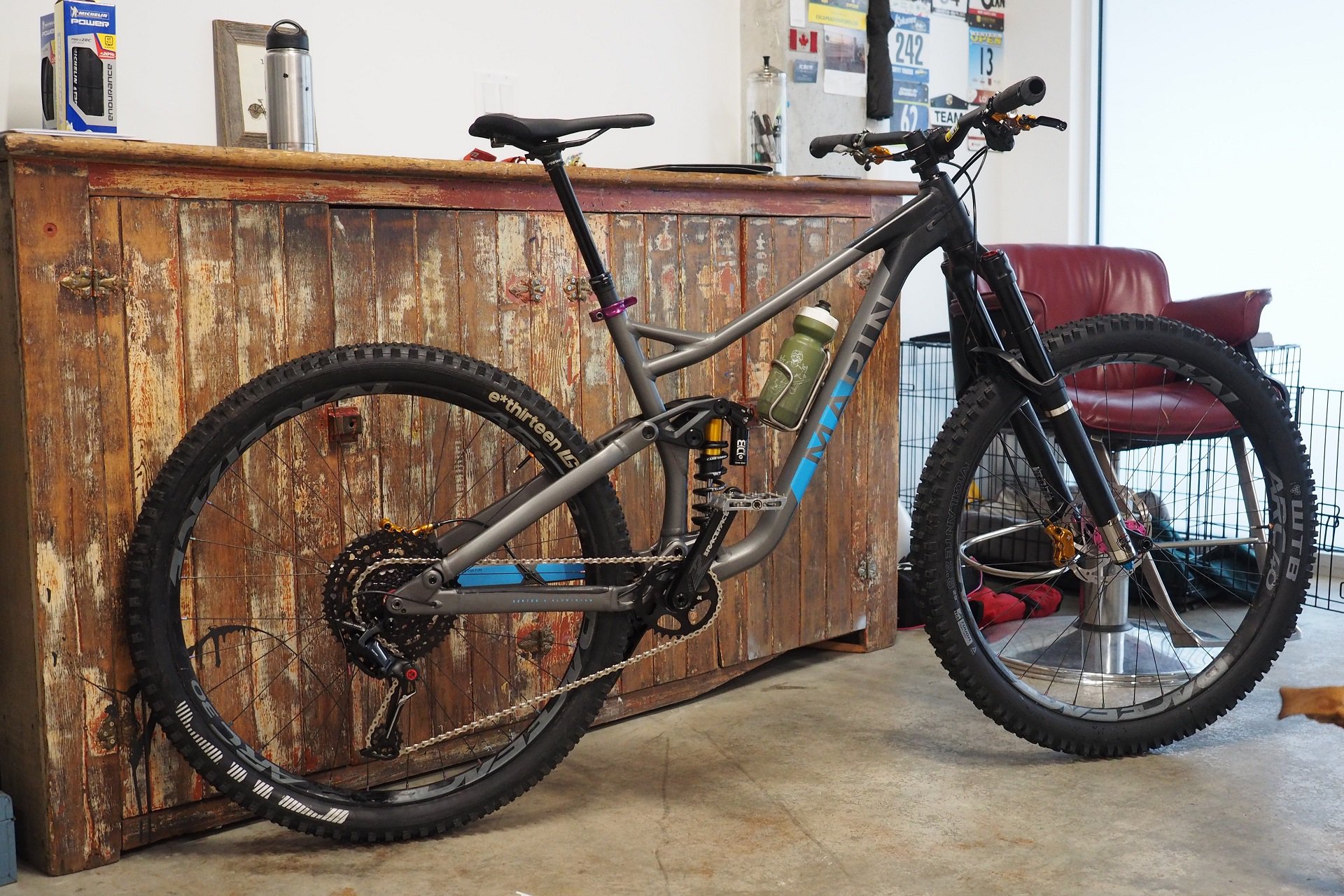
I'm testing the Mezzer on the front of my Marin Alpine Trail - looking fresh here after a Formula Cura4 brake teardown with Jeff @ Wheelthing that will be up on NSMB.com soon.
After a few feet of flat trail I pulled over to the side to adjust the rebound (a lot) and from there I didn't touch the fork settings for the rest of my first ride. Coming off the Mattoc Pro, the new sealed MC² is an entirely different experience. Where the old damper liked to be run with the rebound fairly open (fast), when the new system is set up optimally for the on-trail experience it's going to feel a bit slow on the shop floor. Compared to my Mattoc Pro and Durolux RC2-PCS setups, I've ended up also running my CaneCreek CCDB Coil CS shock a bit slower (LSR) to better match what the Manitou is doing on the trail.
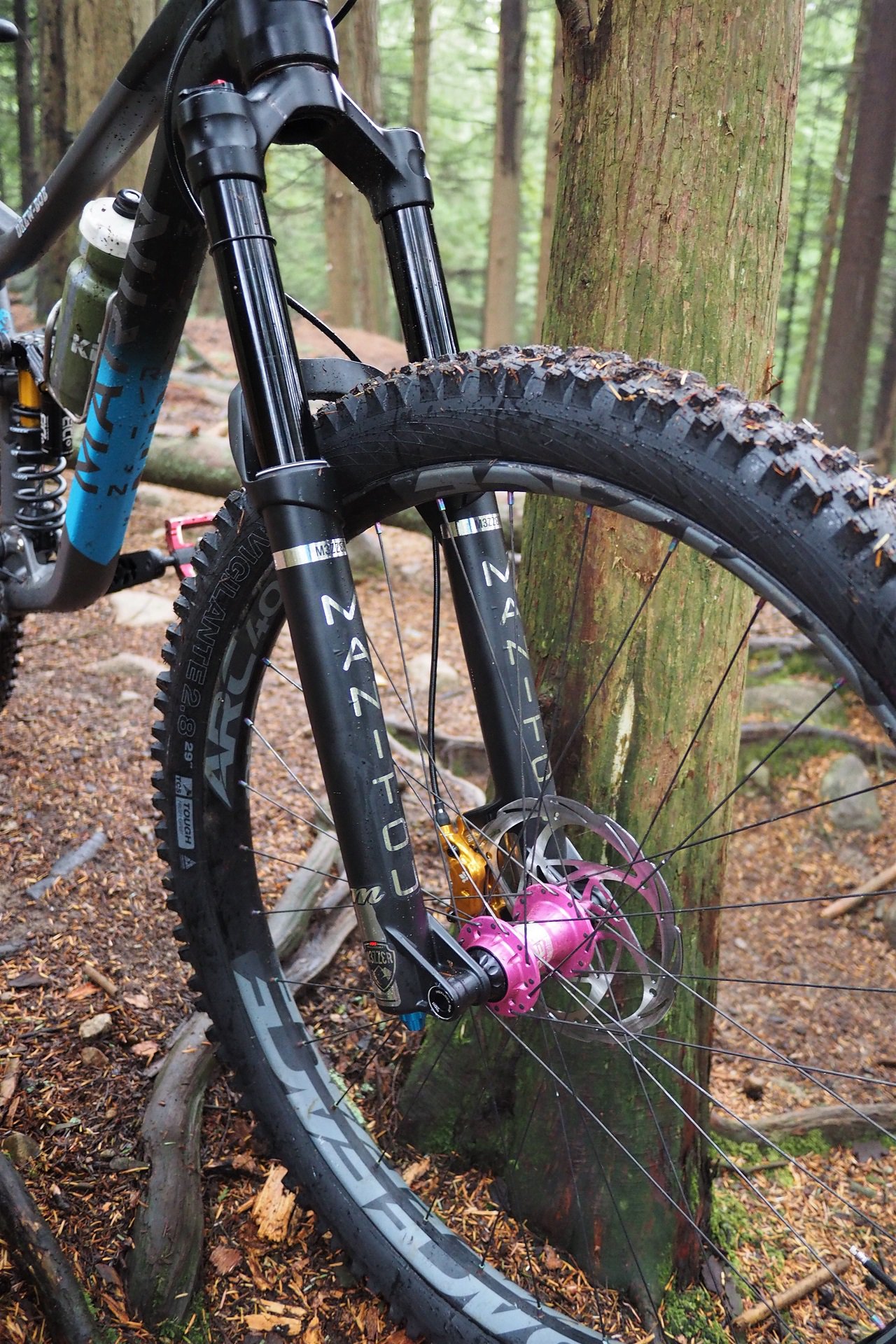
Maximum attention to details in the dropouts, arch webbing, and hollow crown.
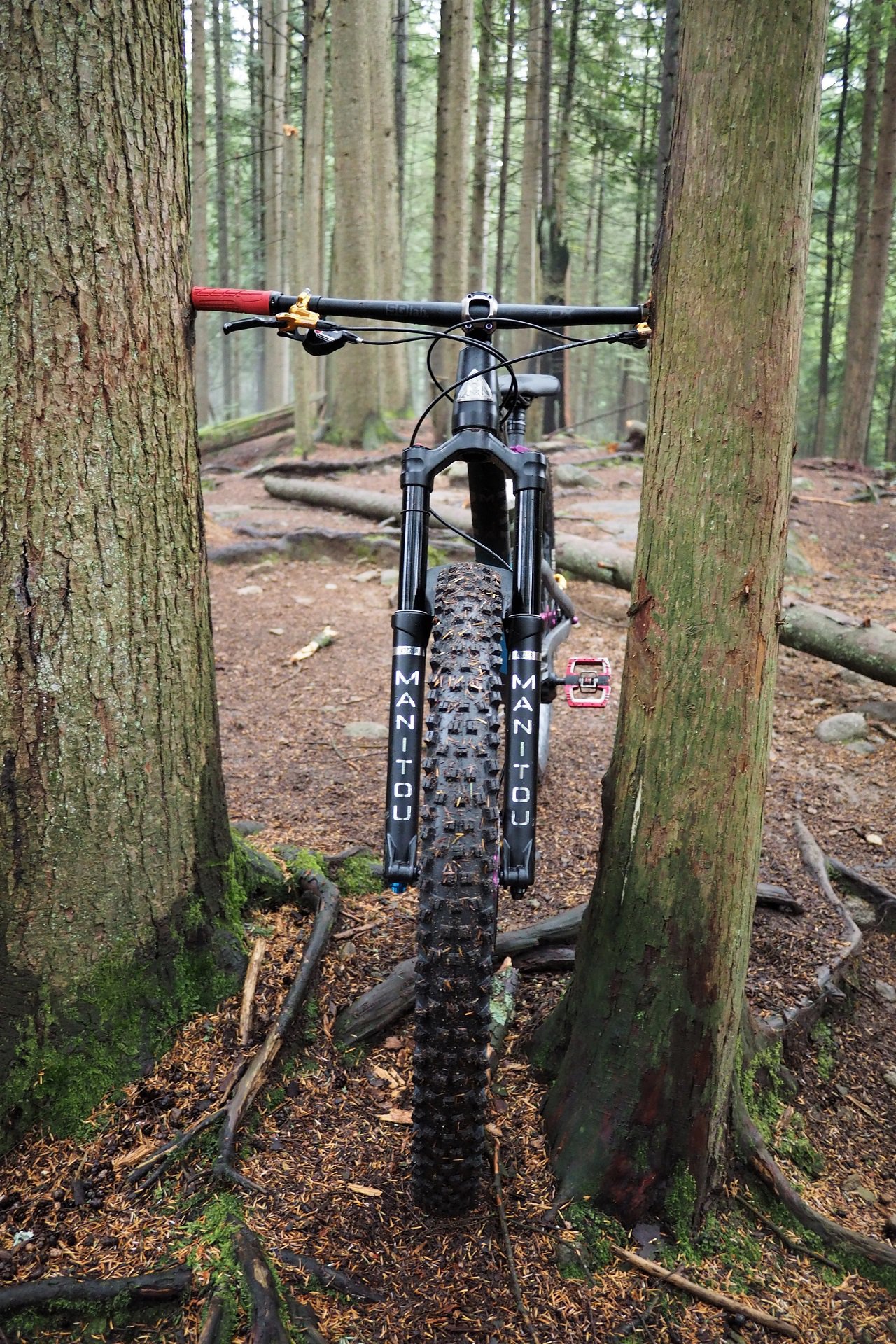
Classic graphics on a beastly looking chassis with gobs of tire clearance.
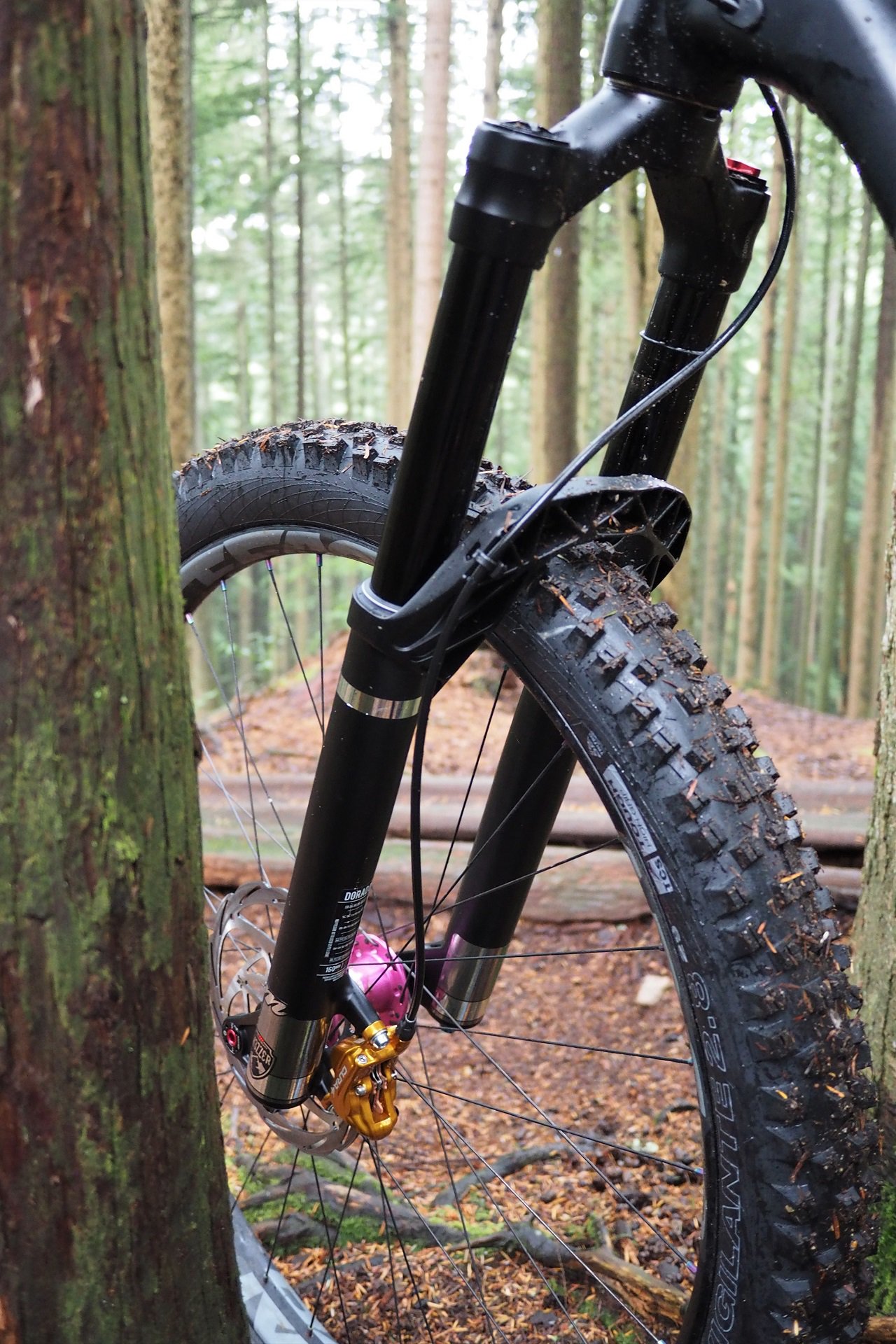
Brake line routed up the back of the fork for a clean look with no rubbing during compression.
The Mezzer Pro felt excellent out of the box and there's been no change after a handful of rides and no noticeable break-in period either. Other than slowing the rebound a couple of clicks I was happy enough with my initial settings that I wouldn't have messed around with them except in the name of science. It will be interesting to see how much my air pressure settings change as I increase the travel to 170mm and 180mm.
Fire away with questions below and there's more information to be found at Manitou.





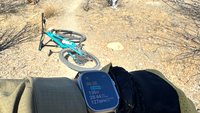
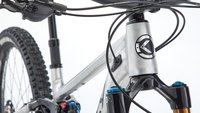
Comments
Kos
4 years, 6 months ago
How does the AC dimension compare to a Fox 36 or RS Lyrik of equal travel?
Reply
Andrew Major
4 years, 6 months ago
The Mezzer 29” at 160mm travel is 574mm.
Lyric 29” at 160mm travel is 571mm.
Fox 36 29” at 160mm travel measures out to ~570mm as well (+/- 1mm or so).
With the long crown-stanchion overlap the Mezzer doesn’t have a bunch of stanchion exposed at bottom out and it’s impressively close to its non-Rear Arch competitors for A2C height with similar rubber clearance.
Reply
Kos
4 years, 6 months ago
Thanks!
Reply
Shinook
4 years, 6 months ago
I've been on one of these for about a month and I love it. I've had 4 or 5 different forks in the past year and a half, the Mezzer is definitely my favorite. My biggest issue being 220ish pounds and riding a lot of natural terrain is finding a fork that is supportive without being insanely harsh, most forks I've tried were either way underdamped and lacked support or the opposite, super supportive but overdamped. The Mezzer really hits it right in the middle: it is compliant, tracks, well, stands up to it's travel when it needs to without diving, and is comfortable. The adjusters seem to have meaningful impact in the bracketing sessions I did, so you can get a firmer or more compliant feel depending on what you are after or what you are riding.
It's my first fork with IRT, which I really like now too. It seems to lack that spiking feel you get with forks that use tokens for progression, where it seems to reach a harsher point in the travel when the progression ramps up. The combination of IRT and HBO seems to guide it into the end stroke a lot easier. I've found myself taking better lines, setting up for corners better, and being able to really get ahead of the bike due to the fork's tracking ability.
My only complaints are pretty minor. The IRT cap should have some kind of seal on it to keep dirt/debris from getting under it onto the top of that cap (the valve itself is sealed, but I've found a lot of dirt under the cap). I've also noticed a minor amount of bushing slop at topout, but it goes away as soon as the lower bushings are engaged and isn't really noticeable riding.
I also found the suggested starting points were a bit on the soft side, I upped the main pressures by 2psi and the IRT by 5 to get a bit more support.
Reply
Andrew Major
4 years, 6 months ago
Cheers!
Very curious, if you don’t mind, where you’ve settled for pressure settings?
Reply
Shinook
4 years, 6 months ago
I'm 215-220 and I am at 75 in the main and 110 in the IRT. I forgot my rebound settings, I can post them when I get back to the bike in a few days, but I'm running it on the faster side.
On the rebound, one thing I forgot to comment on: it doesn't seem like the Mezzer's return from deeper in the stroke (HSR I guess?) is slow like a lot of other forks I've had, which I really like. I've noticed a lot of other forks I've run, it seems like the deeper hits return so slowly that the fork will pack up on repeat large impacts (e.g. rolling down a big staircase at speed), but I didn't have that issue with the Mezzer, which was nice. At least half the other forks I've owned, it felt like they returned too slow and weren't responsive enough from deep in the stroke.
Reply
Andrew Major
4 years, 6 months ago
That’s pretty close to my 1/2 body weight in the IRT and 1/3 body weight in the main. Cool!
Re. Rebound that could come down to IRT vs. the combination of running more sag and more volume spacers to get desired feel & ramp up in other air springs? For example, with RockShox I find a setup that is ‘less damped; more ramped’ works awesome but I have to run the LSR quite open.
Reply
Shinook
4 years, 6 months ago
Totally a theory here, but I think a lot of the benefit people get from volume spacers is the increased rebound speed from deeper in the stroke. If you run a lot of forks totally linear, at least those I've tried, I've found that the return speed is way too slow and overdamped. It seems like the rebound circuits are being tuned assuming some spacers in place, but when they aren't there, the fork returns too slow and you have to either increase air pressure or progression late in the stroke to improve it (or retune).
Personally, I'd rather have a more linear air spring like with the IRT on the Mezzer and a faster rebound from deep in the stroke. I feel like it provides a better feel, improved tracking, and better ride height than running the fork sitting into it's travel with a ton of tokens.
Reply
moraucf
4 years, 6 months ago
Not sure how close the tune is on the mattoc but completely agree about the rebound tune being spot on for my mattoc. Could not get a 36 rc2 feeling good in comparison no matter how many different setting I tried.
Reply
Brad Sedola
4 years, 6 months ago
Bushing slop at top out is something that I've been noticing more and more on my Mastodon too. With it not even being a year old, and me only riding once or twice a week, I didn't expect any sort of wiggle so early in it's life.
Reply
oldschoolsteel
4 years, 6 months ago
I can't remember wanting to see a review on a fork so badly for a while. I'm not sure what it is about this fork that is singing to me, but I definitely want one. This is probably just nostalgia. Manitous were super-cool and shiny when I was a teenager. The polished prototypes for the Mezzer immediately grabbed my attention, and the shiny stickers on the production models held it. Though, I seem to recall a shiny Manitou being pushed aside by a blonde gal named Judy, who was later dumped for a Bomber... and so on. But I guess I still remember that shiny Manitou fondly.
I really hope that dual air pressure works out. It might be a great way to get a fork to feel the way you want it to feel. Seems like a more useful adjustment than tokens.
That travel adjust just looks awesome. It'd be nice to find out what a bike actually likes for travel, rather than what it came with. The fact that the fork came with the adjusters is pretty cool. If they put Lyriks on Doctahawks, you can put 180mm on an Alpine Trail and let us know how it went.
...too bad about the fender and the 2.8 though...
Reply
Andrew Major
4 years, 6 months ago
I have a lot of experience with the IRT air fork coming off the Mattoc Pro where I reviewed both the IVA and IRT air systems in the same chassis. My expectations are high that it will work as well in the Mezzer long term and the big first-look takeaway is really just that it’s simple to dial in good settings - hopefully folks won’t be intimidated by there being two valves.
It’s interesting how any amount of travel in a hardtail is acceptable as long as the HTA is slack enough but folks worry about the travel gap with their FS bikes. I mean as a % going 150/180 is a smaller gap than plenty of short travel bikes people run over forked.
Reply
Brad_xyz
4 years, 6 months ago
Totally agree on the travel gap thing. Shorter rear travel for efficient seated pedaling, longer front travel for less arm pump / numbness after a long downhill. My Patrol was originally a 155 rear / 160 front and I'm running a 170 29er front and would go to 180 if the angles weren't already kind of ridiculous. Although there is always the concern of the head tube exploding due to the extra load....
Reply
Andrew Major
4 years, 6 months ago
I’m not worried about ht-explosion from an extra 20mm of static travel and it’s <1* change... it’s definitely happening as part of the review so we’ll see re. handling!
Reply
yahs
4 years, 6 months ago
Nice review Andrew.
Now I really am going to have a problem deciding on what fork to get in the spring.
Reply
Andrew Major
4 years, 6 months ago
Cheers! I’m genuinely looking forward to logging the hours on this fork to write the full review. It’s been an excellent experience thus far.
Reply
Mammal
4 years, 6 months ago
I have 2 years of hard riding on the Mattoc with IRT, and now use the system on my dorado this season. IRT works really well, especially for those that like to dial in ride feel. Once you find your preferred threshold of pressures, you can easily make very small changes to suit conditions.
Reply
UFO
4 years, 6 months ago
FWIW, the internet conjecture seems to be that as well as the Mattoc's IRT worked, it was a system put in place after the fact. The Mezzer with the IRT designed in allows more appropriate tuning of the respective air springs from the get to.
Reply
Mammal
4 years, 6 months ago
Interesting. The system really is really only affected by the ratio of chamber pressures, so I wonder if this conjecture is related to the volumes of the two chambers being more appropriate in the Mezzer. The Mattoc is quite user friendly, and the main limitation of tune-ability is only shock the sensitivity of shock pressure readings, but the Mezzer appears to run at slightly lower pressures, so I'm not sure how that would help with more appropriate tuning. I'm interested to learn more about the difference in the two systems. Zac...?
Reply
UFO
4 years, 6 months ago
I'm curious about the travel adjust spacers, you write that all is needed is to remove the air side top cap and clip the spacers in. If I am understanding the pictures properly, it looks like the IRT assembly is located at the top cap end. The travel adjustment spacers look to still require removal of the lowers then the air spring assembly (with the special slotted cassette tool), and then popping the travel spacer under the air piston. Please correct me if I'm wrong?
Reply
Andrew Major
4 years, 6 months ago
IRT is at the top, yes. There is a chance that this is a combination of my wishful thinking and/or misunderstanding in terms of being able to just go in through the top (on the Mattoc Pro the lowers did have to be removed) so I will confirm and update.
Either way, an adjusting travel carousel will be included in the full review.
Thanks,
Reply
UFO
4 years, 6 months ago
The IVA uses a similar clip in system, at that IS at the top cap. I'm sure you know this already, but perhaps the travel spacers and the IVA spacers look similar ;)
Reply
Andrew Major
4 years, 6 months ago
Yes, I’ve changed travel with IVA and IRT on the Mattoc Pro. This is my mistake and travel is changed exactly per the Mattoc Pro.
I’ll include a photo carousel in the full review from when I bump it to 180mm. Hoping to do it without oil loss.
Caption in article is updated. Thanks much!
Reply
Brad_xyz
4 years, 6 months ago
@UFO: If you can believe what you read on the internet, the forum thread on the Mezzer on another website starting with m... does agree with what you are describing is required to change travel ;)
Reply
UFO
4 years, 6 months ago
I was kind of hoping to believe what Andrew posted on the internet, as I usually believe everything he posts on the web.
Reply
Andrew Major
4 years, 6 months ago
Sorry to disappoint!
Imagine how awesome it would be if you could just air down the fork, undo a single top cap with an HG Cassette tool everyone owns, and then pop the air system up and adjust the travel with zero oil loss. I mean it's so beautiful that you can almost understand how I convinced myself that's how it worked :-).
Reply
Shinook
4 years, 6 months ago
The process really isn't that much more difficult. It's really important to keep torque right, though, as you could damage the stanchions or rods by over torquing the seal head and/or footnuts.
Personally, for a $1k USD fork, I think Manitou would be wise to provide the slotted cassette tool with the fork. The rest is all done via standard tools, it's a bit of a downer having to buy or craft that to do a travel change, which is something most individuals will want and most shops won't be able to do without the tool.
Reply
mike
4 years, 6 months ago
180/150 hell ya send it!!! And for us mortals that stick with the 2.5WT tires will that fender work?? Oh while on the subject , will a Mudhugger or similar fit?
Reply
Andrew Major
4 years, 6 months ago
Yes, even a healthy 2.6” on an i39 clears fine. With the Reverse Arch I’ve had mixed results modifying other fender options so I’ll stick with factory.
Reply
Patrick Kramar
4 years, 6 months ago
Without fender 2.8,with fender 2.6
Reply
Brad_xyz
4 years, 6 months ago
Incidentally, if there is really a Fox '38' single crown fork in the works, it sounds like that would go head to head with this Manitou Mezzer fork. That would make my 'next fork' decision all the more difficult!
Reply
Patrick Kramar
4 years, 6 months ago
Why? There will probably not be any great new trickery be going on except the 38mm stanchions. Such marketing nonsense. The gap between the 36 and 40.the 36 is sufficient fat and offers up to 180mm travel. Where is the need to go 38 in that line up. For manitou with a pike like trail fork mattoc with 34mm stanchions, there was a huge gap indeed. Fox will not bring something different than an overworked evol spring where as manitou 9ffers an irt, which is so much better than a token modified solo air. I had many forks with irt or the runt and can say this is just a level above those single air springs. And as it seens in the MTbr forum all mezzer owners love that fork over the rest, at least when they dialed it in.
For me it is clear I will get me a Mezzer. Or better said, I just ordered 2 days ago. As as had 2 mattocs I am sure I will not be disappointed
Reply
JVP
4 years, 6 months ago
> Speaking of the crowns, the stanchion-crown pressfit overlap is massive and between the crown steerer, lowers,
This is good to hear. So many forks going in for warranty due to weak-ass crowns.
Reply
Brad_xyz
4 years, 6 months ago
I'm super stoked to hear more on this fork and how it compares to the Fox 36:
After riding a long line of RS Pikes and Lyriks, the Fox 36 Grip 2 blew my mind with its incredible composure and mid-stroke support (almost too much mid stroke support with the Vorsprung Luftkappe). As a big guy I can huck into the worst, rockiest landing and know what the airspring and damper are going to do every time. It rides so high in its travel normally that according to my shockwhiz its dynamic sag averages 5-10% less than its static sag! It never wallows or bottoms with a metallic clang and never suddenly and unexpectedly blows though its travel. The same cannot be said of the RS forks I've had. It may not be the softest fork on the hands but it has saved my a$$ more times than I can count.
However, the Fox is pretty flexy for a big guy like me (both fore and aft and torsionally) and creaks (to me it doesn't seem like this is the 'normal' stanchion / CSU interface creak that seems so common, it is more of a 'ping' that sounds like the headset getting loose and they settling again as if the steerer is elongating under stress). In any case I'm now looking for that unicorn that has the support of the Fox combined with a stiffer / stronger chassis and yet is still easier on the hands over long rough descents. :)
Incidentally Andrew, about your remark:
"if I was buying a Fox fork I would choose a FIT damper over GRIP every day of the week because I ride a lot and I find they perform consistently better over the full period between service"
I've had my Fox 36 Grip 2 for over a year of pretty regular riding (summer and winter) and have done nothing to it other than periodic lowers service and air spring re-lube and to me it still feels as good as the day I got it. Since the damper is auto bleeding I thought it should actually be more consistent over the service interval as long as you keep the damper side oil clean. I'm very curious to hear about what issues have you heard of or experienced with the Grip 2.
Reply
Andrew Major
4 years, 6 months ago
“As long as you keep the damper side oil clean”
Exactly. Where bled/bladder FIT, Charger, Roughcut, etc, and the new MC2 to a large extent isolate damper fluid from the bath oil open forks like the old Fox Open-RL setup or the current Grip are cycling bath oil through the damper. Crap in the bath oil becomes crap in the damper fluid.
You’re in a rare percentage of Grip fork owners if you’re changing the bath oil often enough that it’s staying that clean. Which is awesome! But definitely a minority of owners including sponsored riders and you :-)
(I tease).
For me, FIT4 works great-enough and fits (haha) with my service interval.
Reply
Brad_xyz
4 years, 6 months ago
LOL, now you've got me worried.
I don't think I was obsessive before about changing the damper oil / servicing the lowers but now I will be :) Maybe I'll add in a quick damper side oil change in between actually dropping the lowers and doing the wiper seals / foam rings.
Reply
Andrew Major
4 years, 6 months ago
With the GIANT disclaimer that different riders, in different locals, riding different distances, ways, etc will have different experiences and I always recommend going with with your experience and/or the best local advice...
The new SKF made seals that Fox (and RockShox) use are astoundingly better than the old models in terms both smooth action and resilience and unless they look really dirty inside when you pull the lowers you should be able to get a lower service (clean / fresh oil) out of a set without having to change them.
The average local rider (Shore To Sky) is well served to do a basic service every 50hrs (just clean/fluids) and a full service every 100hrs (seals, bleed damper if it’s a bladder model, air system).
Some riders who do a lot of winter miles will add an extra lower service just to keep everything clean but again no seals as they should last ~100hrs if riding.
YMMV, always follow the manufacturers’ recommendations, etc, etc...
Reply
[user profile deleted]
4 years, 6 months ago
This comment has been removed.
Shinook
4 years, 6 months ago
Most suspension tuners I know prefer the FIT4 to the GRIP2, for several reasons, one of which being the ingestion issue mentioned above. My bath oil tends to get dirty pretty quickly, the idea of it being cycled through the damper seems really poor. The fork also lacks the benefit of a bladder, which is supposed to provide better sensitivity.
The benefit of the GRIP2 is more adjustability for the end user, though. Most of the tuners I know can re-shim their FIT4 to feel correct and address the spiking HSC, slow HSR, and other tuning issues that the damper comes with stock (depending on weight). The average user can't do that, so the GRIP2 provides that external adjustment and a better feel despite deficiencies in comparison to the FIT4.
I prefer the Mezzer, but the GRIP2 had a firmer, racier feel than the Mezzer did. I was able to get the Mezzer closer to the GRIP2 feel by closing off the HSC and increasing the IRT, but I found the GRIP2 wasn't really able to be adjusted for as compliant of a feel without dive. Given the reviews, I expected to be blown away by the GRIP2, but I thought my Helm was close in feel, the Mezzer was overall better, and the PUSH tuned 36 FIT4 was better. I think the main thing people will get out of the GRIP2 is the ability to get the fork to respond faster than most stock tunes will via the wider range of rebound adjustments in comparison to others on the market.
Reply
Brad_xyz
4 years, 6 months ago
That’s a really good and insightful comment and also generally agrees with my experiences on my Fox 36 grip 2. Thanks for commenting; it definitely makes me want to try the Mezzer although I really do enjoy the “firmer, racier feel”, on everything short of really high speed DH rock and root gardens and high speed braking bumps. For super steep low speed tech that ‘feel’ it hard to beat IMO.
Reply
Jeff French
3 years, 11 months ago
Old response. I have a 2019 (or 2020, I don't remember, doesn't matter) Fox Factory Grip2 160mm. I'll be installing a DSD Runt (basically the same as IRT) and I have read great things about those Grip2 owners that have made the installation. Might be worth a shot at $200 before changing out your fork.
Reply
Humanpowered
4 years, 6 months ago
I'm really interested in this fork. I'm currently running a Lyrik at 170mm with the Luftkappe and Push's HC97 damper (really great). I like my fork a lot, but the Mezzer might just be the thing to replace it.
Reply
Jcmonty
4 years, 6 months ago
You may want to check out the DSD runt for the lyrik if you are looking at mimicking the IRT. Same concept. I have one, along with the hc97, and like it a lot. More mid stroke support and able to run lower main chamber pressure for off the top suppleness. High speed is great with the hc97
The mezzer definitely is high on my next-fork list for the features out of box though.
Reply
KenDobson
4 years, 6 months ago
Can you show the process of taking apart the valve/ bladder and rebuilding, oil volume and bleeding? I have a Mezzer but find for my area Im far below the air pressures suggested. 35/55 for me at 165lbs ridding rocky rooty steep trails in NorCal. I also have reduced the travel to 150mm. My fork arrived virtually dry inside and had to lub all O rings and seals plus added oil in both legs. Now its very smooth and great on small bumps and great support in mid travel. The HBO is alittle firm so as of now I dont seem to be riding hard enough to get the last 20mm of travel.
Thanks for the great write up.
Reply
Jonathan Booth
4 years, 6 months ago
If they ride as well as you say their retro appearance will be a good match for some of the boutique steel bikes, like the Starling etc.
Reply
mzro
4 years, 6 months ago
Good read and review, as always. Andrew, do you think it will fit 28x3.0 tires, like Bontrager XR4/SE4?
Reply
Andrew Major
4 years, 6 months ago
Thanks!
Based on my measurements an SE4/XR4 on an i40 rim clears with healthy-enough clearance. They are a bit larger volume than the 2.8” Vigilante but they’re also a lot rounder.
I don’t have one mounted on a rim or I’d confirm that absolutely with photos for you, but that’s as close to yes as I can do.
Reply
Holger Baer
4 years, 5 months ago
Sounds like a Maxxis DHR II 3.0 should fit fine, too. Did you ever tried those or any other Maxxis 3.0´s?
Reply
Andrew Major
4 years, 5 months ago
I haven't had the opportunity to ride the DHR II in a 3".
The DHF in a 3" is an okay tire at best. The DHF is fantastic in a 2.3" size and it's pretty good in a 2.5" size but as the distance between the center and side knobs gets bigger and bigger the resulting performance decreases.
I'm still working on the review, but the WTB Vigilante in either the Tough Casing / High Grip or Light Casing / High Grip - depending on application - is currently my first choice for a 29+ tire. I also had a great experience with the Bontrager SE4 3" although the rubber isn't as good as the WTB.
Reply
Holger Baer
4 years, 5 months ago
thank you Andrew!
Did you rode the vigi 2.8 out back too?
Reply
Andrew Major
4 years, 5 months ago
I haven’t ridden the 2.8” Vigi out back on a 29’er.
I have on a 27+ bike (Growler) and my next hardtail will have a bit more clearance so I can run it (or a similarly aggressive 2.8-3” tire) out back as well.
Caveat, I ride by myself a lot so if it takes me a couple minutes longer to get up the climbing trails I really don’t care if it’s more fun down.
Holger Baer
4 years, 5 months ago
This comment has been removed.
Mammal
4 years, 5 months ago
Tangent, but I find it interesting that you find the DHF 2.5 less satisfactory than the 2.3, as I've had the opposite impression. Are you referring the 2.5 WT or the old school one (pre-wide rims)? I'm fairly certain the size and spacing of the knobs were proportionally scaled up for the WT version.
I found that as rims got wider, the 2.3 Minion had way too square a profile (29-30mm internal rim). Once I moved to the 2.5 WT, that tire gave me better overall performance than I ever had with the 2.3's, regardless of rim width. Probably a lot of that is due to the increased volume, but front seemed to transition more evenly from middle to side knobs better than my previous experiences. Fantastic even knob wear throughout the tread pattern as well. And I've been running DHF for a decade an a half. Interesting...
Reply
Andrew Major
4 years, 5 months ago
The last DHF I owned was a 29x2.5 WT 3c EXO and I had it on an i29 rim. It was totally good. But, with the caveats that I’m talking about front tires here and don’t care about rolling resistance, I preferred the 2.35 Magic Mary, 2.35 TRSr/LG1r, and the 2.5” & 2.6” WTB Vigilante I’ve ridden since.
As part of the Chameleon review I found myself back on the 2.3 DHF and it was eye opening how good the transition is between the center and the side knobs. Rolls fast too; especially for the traction it delivers. I feel that the 2.3 DHF is precise and predictable and then as the tires balloon up the transition from center to side gets less and less so.
Take that with a few grains of salt. I’m not wicked at cornering or super fast and personally I’m full in the 29+ and 29+/- bandwagon.
Holger Baer
4 years, 5 months ago
This comment has been removed.
Endur-Bro
4 years, 6 months ago
FORK OFF!
Seriously; all the top forks: RXF 36, Helm, Lyric, GRIP2 36, Selva R and this
Reply
Wilson
4 years, 2 months ago
Hey Andrew, any comments on bushing play? It sounds like known issue from what I’ve read about this fork - I’ve also read that there’s a fix in the works from Manitou. Looking forward to the full review! Nice work - thanks.
Reply
Velodonata
4 years ago
I ordered a Mezzer in late December and it seems that they have resolved the issue with early production Mezzer lowers and bushing play. As I understand it, they pulled unsold stock and replaced the lowers and then redistributed the repaired forks. Mine came in a box that had been obviously opened and resealed with Manitou logo tape, and had an earlier production date on the box than I would have expected for a fork that took a few weeks to ship in January. And I believe they have shipped warranty lowers to anyone that needed them. My Mezzer is great so far, it is tight and smooth and I am very happy with it, it is the best fork I have ridden.
Reply
Please log in to leave a comment.